| |||||||
| Search Forums |
| Advanced Search |
| Go to Page... |
 |
| Search this Thread |  44,380 views |
| | #1 |
| Distinguished - BHPian  | Pics: Inside Honda's Rajasthan Factory. Detailed report on the making of Hondas 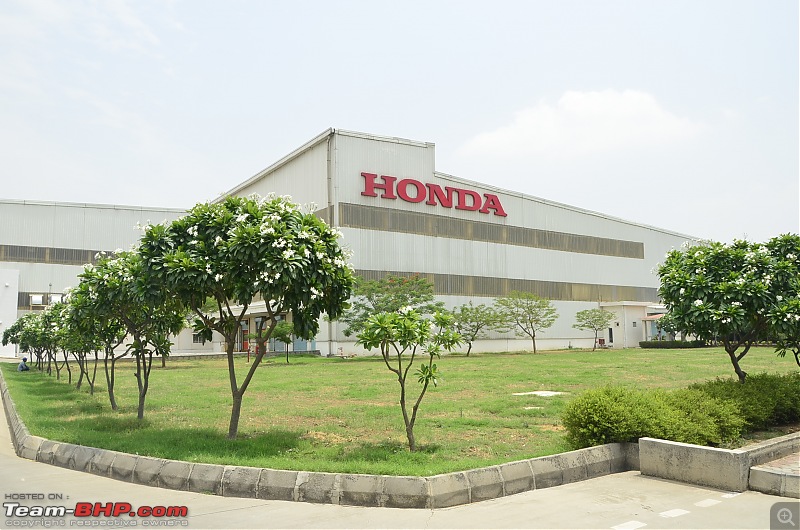 Having never visited a car manufacturing plant in my life, I now firmly believe that it's a must have experience for every petrolhead to understand the detailed intricacies of how our “objects of desire” are made. And what better plant for a maiden visit than that of one of the Japanese car manufacturers - Honda. It was a pleasure to be part of a guided tour where they took us through the entire process of car making. Most of the IT Engineers would know that it was like going through an entire SDLC (Software Development Life Cycle), right from seeing the long pieces of steel billets to the final finished car rolling out of the assembly line. I was given a heads-up by GTO that most probably, they might not allow cameras inside or will be reluctant to let me take pictures of the parts of the factory, machines etc. But I was pleasantly surprised when Honda did not outline any such restrictions at any given point of time, except for one part of the assembly line (more on that later) and of course, the paint facility which is always a taboo area for multiple reasons (more on this as well later). Well, I’m far from technical, both in my professional life (I sell software and services for a living) as well as personal life (personal interest level wise) and therefore, please treat this report as a pictorial report of the Honda Factory through the eyes of a regular car enthusiast. My intention is to keep this report simple and in the same flowing format as the way a car is manufactured. Visiting the Honda Plant at Tapukara, Rajasthan was a memorable experience. This is their 2nd manufacturing facility apart from the one they have in Noida, UP. This facility is spread across 450 acres with well-kept internal grounds and plenty of greenery all around. As soon as we entered the facility, first thing we all did was plant a tree which was an enjoyable activity. The Tapukara plant is situated in the Alwar district of Rajasthan and the Chief Minister of Rajasthan Ms. Vasundhara Raje inaugurated it on February 27th, 2014. The first car that rolled out of this facility was a Honda Amaze. Quick Facts: • TAKTZEIT (time interval) 114 seconds - which implies that every station finishes off its designated job on one car in this short time! In other words, one car rolls off the assembly line, every 114 seconds. • Daily Output - 480 cars in 2 shifts of 8 hours each. 3-shift capacity: 720 cars. • Daily Engines Manufactured - 480. • Engine Test Bench - The Tapukara plant boasts of an ETB with 150 kW-330 kW dynamos to carry out durability and high-speed tests for the engines. • Models manufactured here - City, WR-V, BR-V and Jazz. • 1 Batch - 60 Cars. They control the production at HCIL in batches, where every batch of 60 cars would be of the same colour, variant and engine type. • Transmission exports - Tapukara handles the export of fully assembled 5-speed MT gearboxes to 9 countries, including the UK, US, Canada, China, Brazil, etc. • Installed production capacity - 1,20,000 units/year. • Employment - Approximately 3,200. • Cumulative Investment - Rs. 3,526 crores. • 2nd manufacturing facility in India, thereby increasing the production capacity of Honda Cars to 2,40,000 units / year. • As per Honda officials, this plant is 90% localized and the only non-localized components are the electronics or sub-units of the larger electronic units. • From Jan 1, 2017, HCIL has switched to a 5-day working calendar, à la Maruti Suzuki. Team-BHP's earlier Factory Reports - For those interested in the science of car manufacturing! Ford's Chennai Factory Jaguar's Castle Bromwich (UK) Factory Eicher Polaris factory in Rajasthan Tata Motors Factory Hyundai's Chennai Factory AMG Factory Visit Maruti-Suzuki's Manesar Factory Apollo Tyres Chennai Factory Piaggio's Vespa Plant Ford's Plant at Sanand Last edited by Aditya : 4th September 2017 at 10:38. |
| |  (34)
Thanks (34)
Thanks
 |
| The following 34 BHPians Thank mobike008 for this useful post: | Aditya, aniket17, anshumandun, asingh1977, blackwasp, CarguyNish, dailydriver, Grand Drive, GTO, himanshugoswami, Jaggu, jetti, Leoshashi, libranof1987, Mevtec, Mr.Boss, Nohonking, phoenixash, pulsar56, RaghuVis, rahul4640, RavenAvi, Rehaan, sdp1975, shipnil, Simhi, Singh09, skchettry, SmartCat, sri_tesla, The Brutailer, The Rationalist, theexperthand, Turbanator |
| |
| | #2 |
| Distinguished - BHPian  | I will try to keep the report as simple as possible with some basic explanation and the correct order of how the car is manufactured from scratch. Therefore, we'll follow the below sequential processes and I will dedicate a post for each of the steps. Alongside, I will be sharing pictures & videos to illustrate how meticulous and laborious the entire process of building a single car is. Crankshaft & Conrods 1. Forging 2. Machining 3. Diecasting 4. Powertrain (Engine Cylinder Block, Cylinder Head, Transmission) Car Assembly Plant 5. Press Shop 6. Weld Shop 7. Paint Shop 8. Assembly - Engine 9. Assembly - Frame 10. Vehicle Quality & Quality Assurance This was my first view of the factory; it's about 1 km inside from the main Delhi-Jaipur highway: 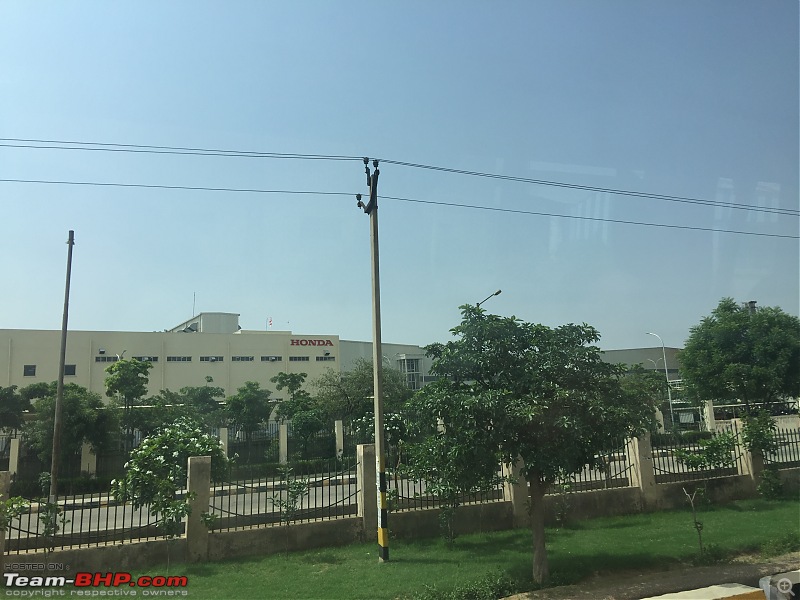 Last edited by Aditya : 4th September 2017 at 10:38. |
| |  (21)
Thanks (21)
Thanks
 |
| The following 21 BHPians Thank mobike008 for this useful post: | Aditya, aeroamit, aniket17, anshumandun, BlackPearl, blackwasp, CarguyNish, dailydriver, GTO, Leoshashi, libranof1987, Mevtec, Nohonking, phoenixash, RavenAvi, Rehaan, shipnil, SmartCat, sri_tesla, tharian, theexperthand |
| | #3 |
| Distinguished - BHPian  | The Tapukara Plant is about 100 km away from Gurgaon, Haryana. It took us two hours to reach there in the Volvo buses that the company had arranged, due to the heavy traffic encountered while getting out of Gurgaon. We reached the plant at ~9:30 am and it was a pleasant surprise to at once notice that the massive 450-acre complex is extremely neat and well maintained. After a group picture in front of the main building of the Honda plant, the officials ushered us to an open field close to the main building where we were requested to plant trees. We all were given a small sapling. This was the second time I planted a tree (first time was at an orphanage during my college days)  . .Yours truly planting a tree at Honda's Tapukara Plant: 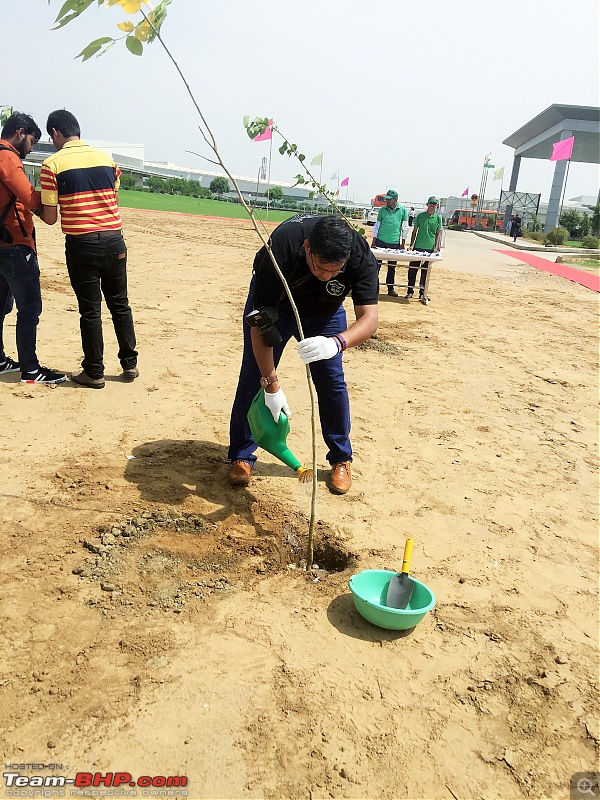 My contribution of one tree on this planet: 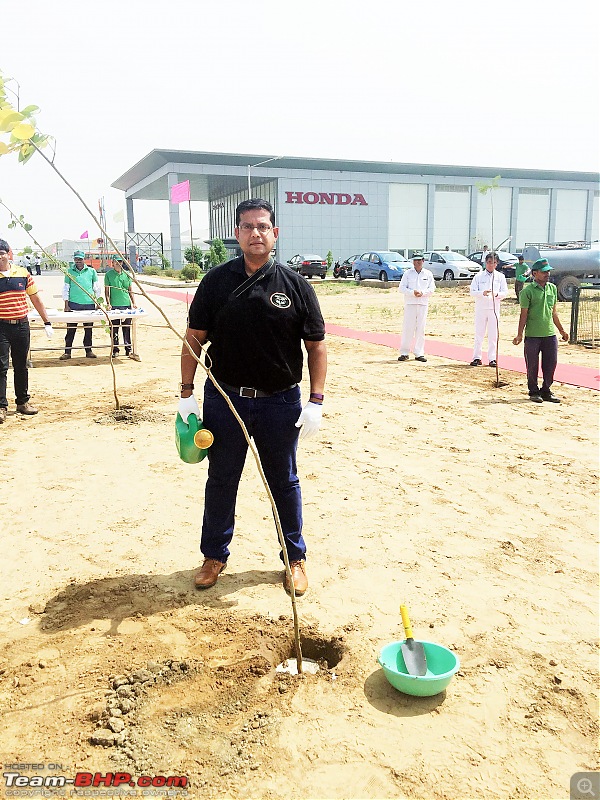 Hoardings that called out the tree plantation event by the media: 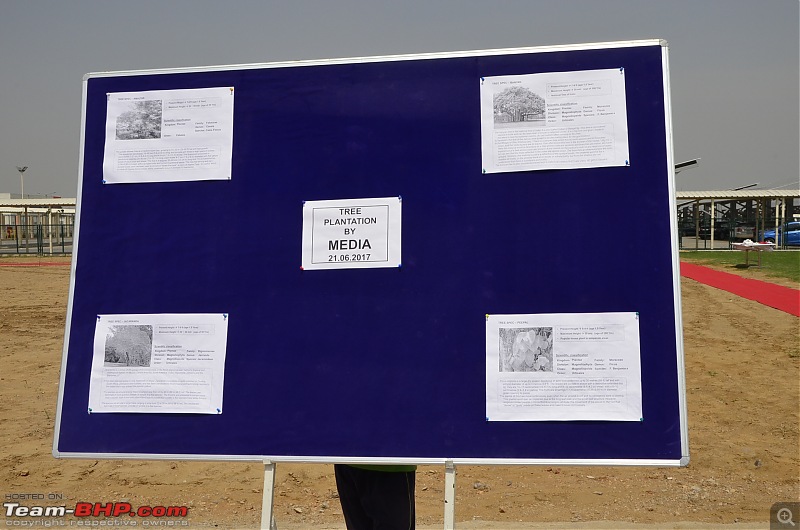 A glimpse of the ground: 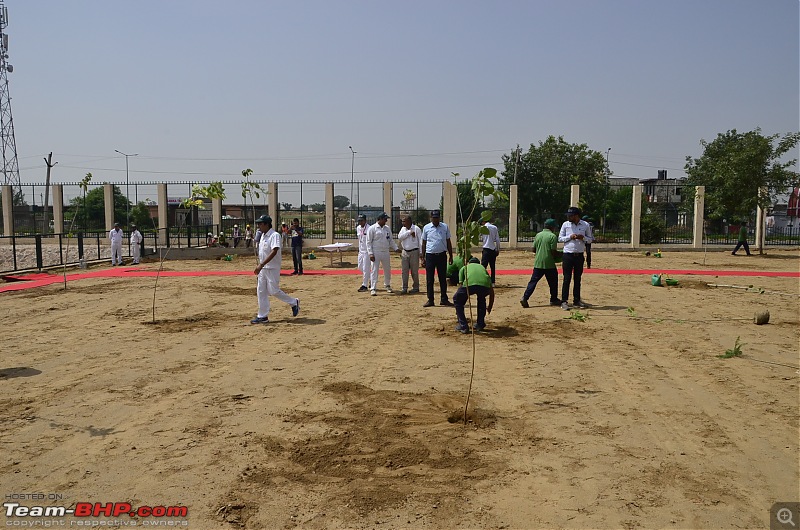 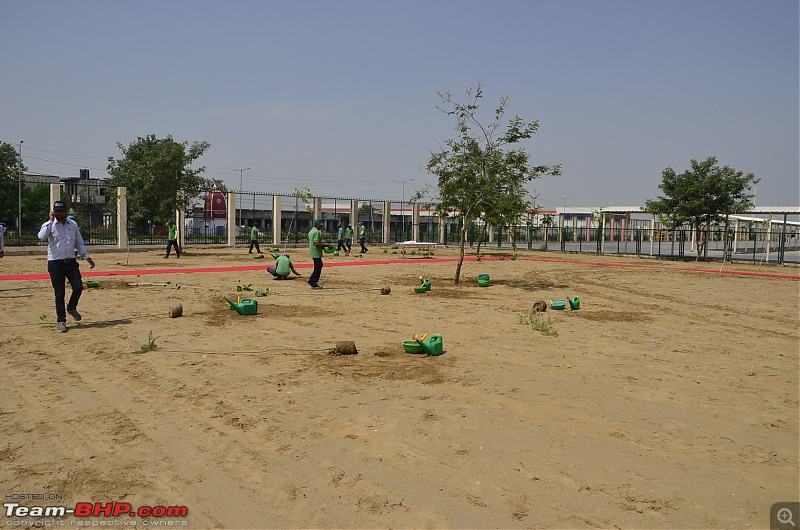 Attention to detail - all of us were handed these gloves for the plantation: 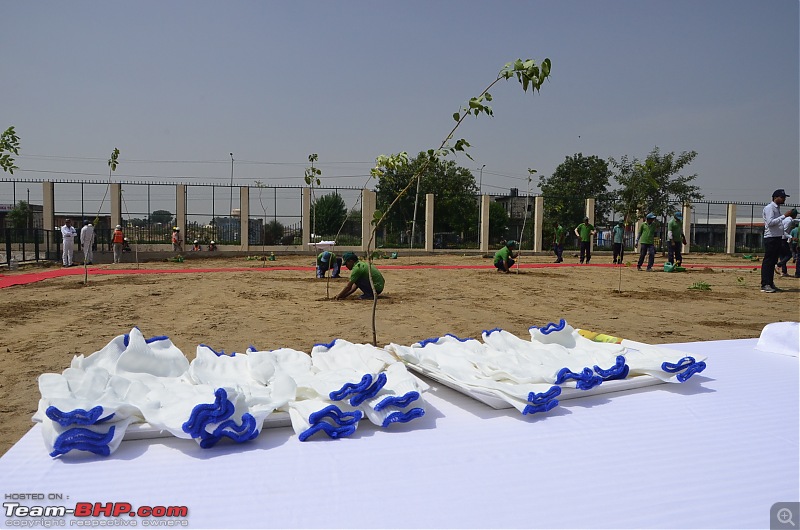 Internal roads within the factory premises. It was spic and span everywhere: 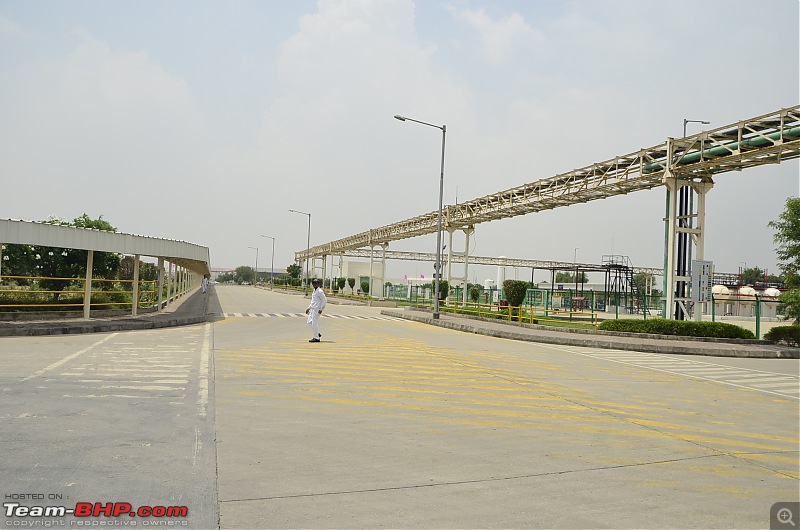 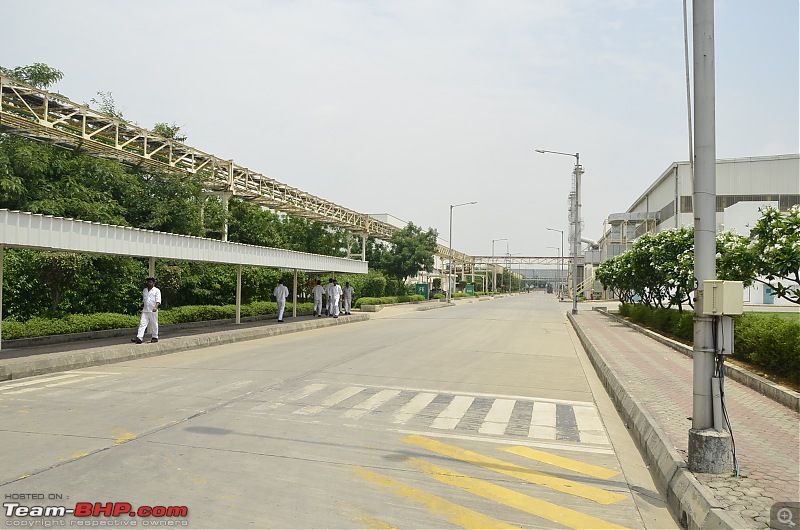 Lots of greenfields: 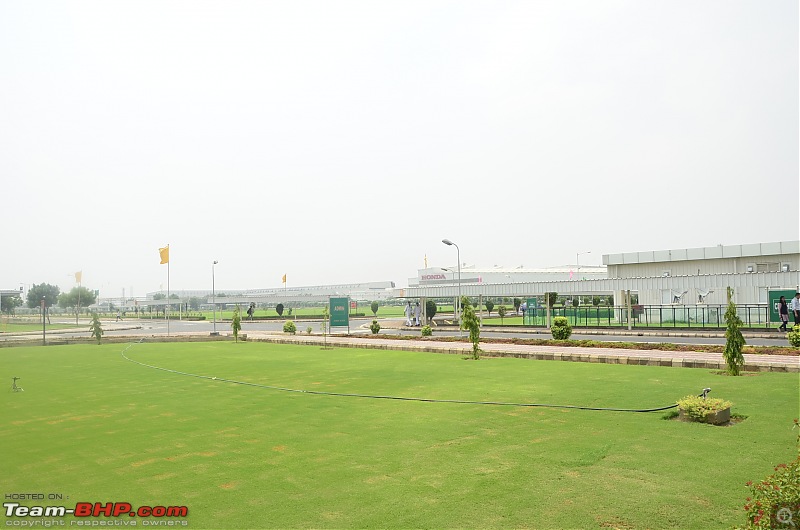 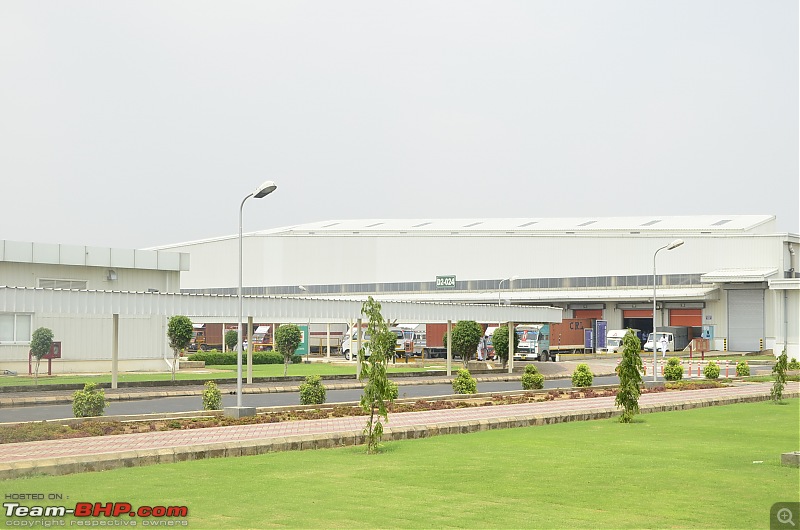 All buildings are lined up as per the assembly line processes: 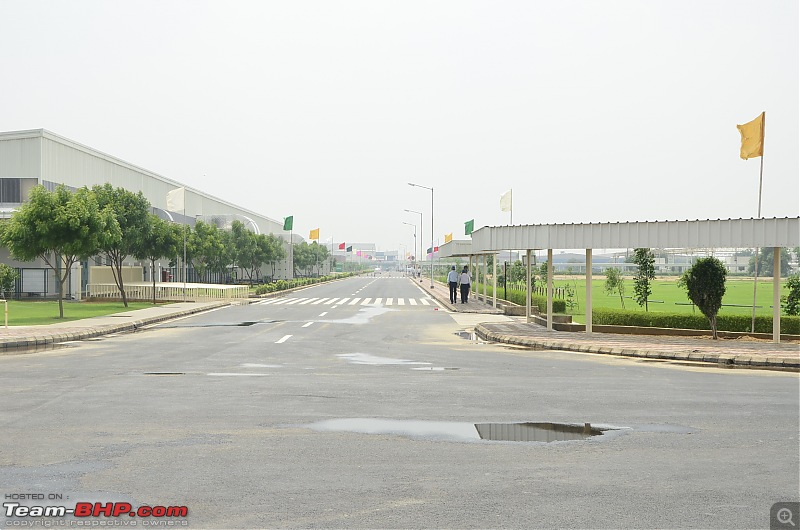 Spotted this brand-new Amaze parked in the factory premises. Wonder what it was doing here as the Amaze is built in Noida, not Tapukara: 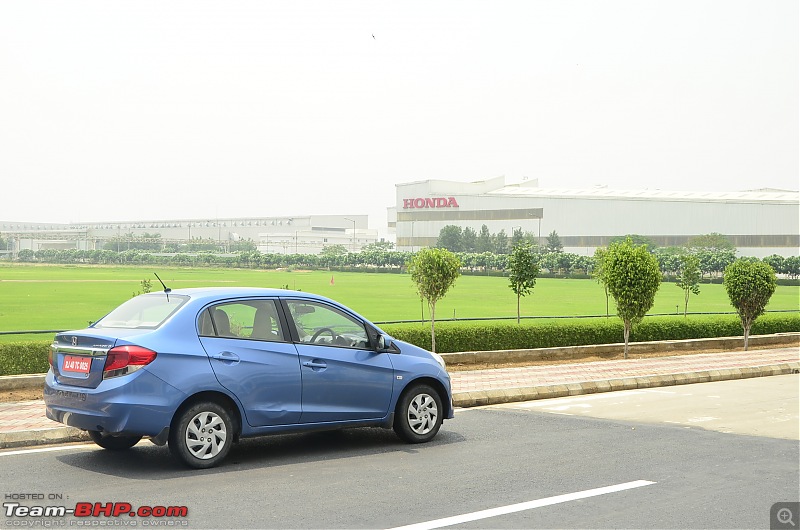 A scale model of the entire plant in the main hallway of the Honda Office Building: Last edited by Aditya : 4th September 2017 at 10:39. |
| |  (27)
Thanks (27)
Thanks
 |
| The following 27 BHPians Thank mobike008 for this useful post: | aabhimanyu04, Aditya, aeroamit, aniket17, anshumandun, BlackPearl, blackwasp, carrazy, GTO, Haroon, himanshugoswami, Jaggu, Leoshashi, libranof1987, Mevtec, Nohonking, phoenixash, pixantz, RavenAvi, Rehaan, samabhi, sdp1975, Simhi, sri_tesla, theexperthand, Turbanator, vaasu |
| | #4 |
| Distinguished - BHPian  | By the time we finished the tree plantation activity, it was 10:00 am. We moved inside to the Welcome Hall where the senior Honda officials, including President & CEO, Yoichiro Ueno, SVP-Marketing & Sales, Jnaneswar Sen, senior engineers from production and R&D departments, and the corporate communications team were present. We were quickly briefed about the do's & don’ts of the entire visit and within 15 minutes, we were off to the actual factory floor. They told us that we would be seeing the entire car manufacturing process - from the beginning to the end as it happens. Being my first time at such a facility, I was waiting with bated breath for the tour to start! The Tapukara car plant is an integrated drivetrain manufacturing and vehicle assembly unit. We started from the engine and components manufacturing section, and later moved towards the final car assembly. The company makes its own engine blocks, cylinder heads and crankshafts in-house at this factory. The facility has a sprawling campus and a good amount of road spacing between various shops. Ferrous parts section First in the manufacturing sequence was the Ferrous section, designated to produce the crankshafts from scratch and machining of the connecting rods, obtained from outside. The building from where we stepped inside this area was the ‘Forging’ shop. This is the very first step in building a crankshaft, where the steel billets (raw materials) are put through a forging machine to bring them to the shape of the crankshafts. Forging is a manufacturing process involving the shaping of a metal into a particular design, using different time duration of pressing forces applied by specific machines. It is often classified as per temperature - hot, warm and cold. For the former two, the metal is heated, usually in a forge. Forged parts can range in weight from less than a kilogram to hundreds of metric tons. In the Tapukara plant, the forging machines range from 1,000 tons - 4,500 tons and the plant has 5 and 2 machines of the capacities respectively. Steel billets are first tempered at around 1,200 degrees Celsius and are subjected to some powerful blows, delivered in a sequential manner by these powerful machines. To augment this work at a rapid pace, there are 9 robots deployed to carry out the whole process of billet feeding and undermining of the ready crankshafts from the forging machines. Production Capacity: 1,400 car sets / day or 3.80 Lakh car sets / per annum. Forging as a process is widely used for any kind of machines that need high levels of strength, and it has become an industry in itself. Forging can produce a piece that is stronger than an equivalent cast or a machined part. As the metal is shaped during the forging process, its internal grain deforms to follow the general shape of the part. As a result, the grain is continuous throughout the part, giving rise to a part with improved strength characteristics. Some metals may be forged cold, but iron and steel are always hot forged. Automotive manufacturers have great confidence in its reliability because vehicles need to carry heavy weights at high speeds, and so, these better be light enough to save fuel. Entrance of the main building of the Honda Plant: 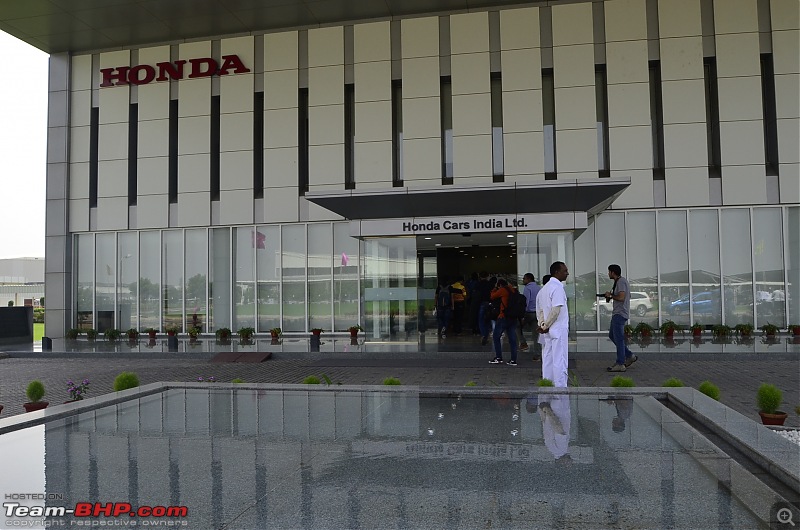 A "Muggu" / Chalk design to welcome the media: 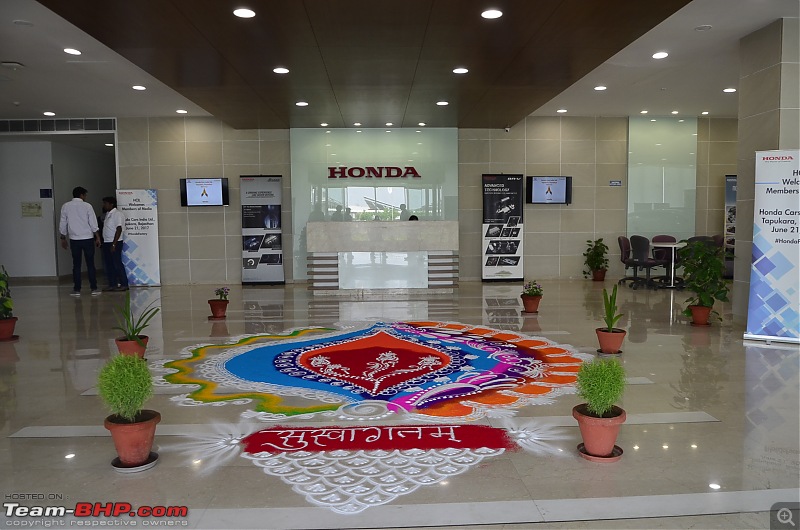 Presentation room where they informed us of the "Do's" and "Don'ts": 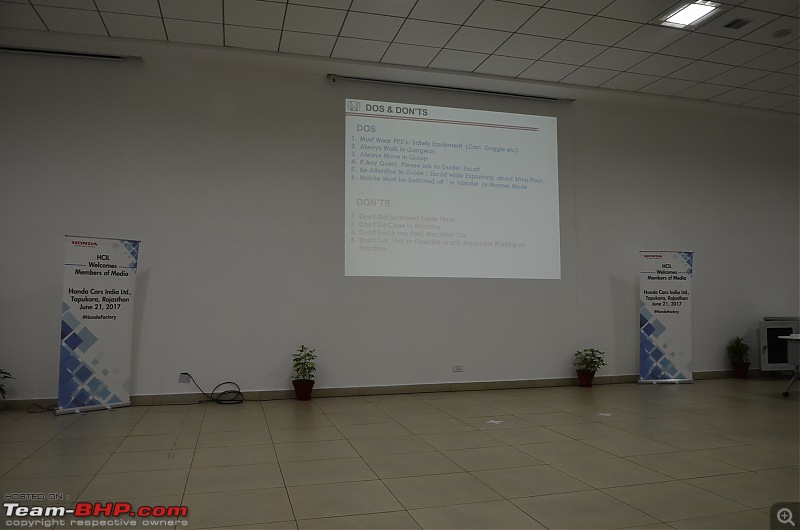 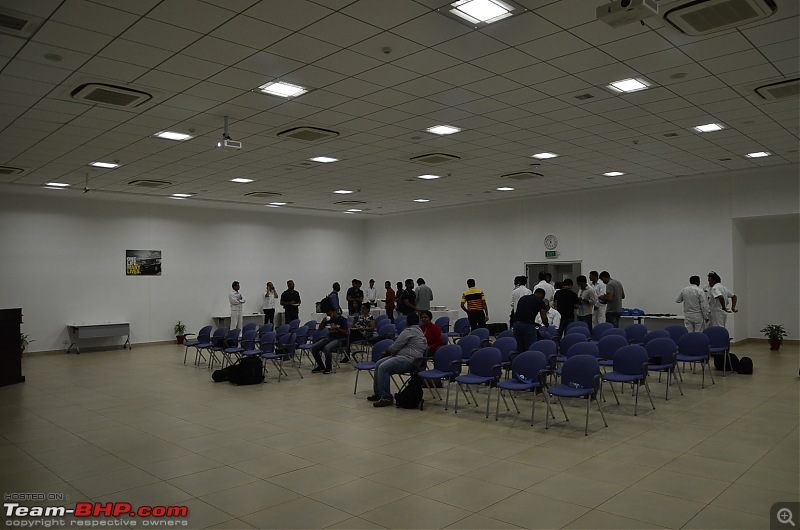 After the initial briefing session got over, this was the first part of the guided tour - "Forging" section: 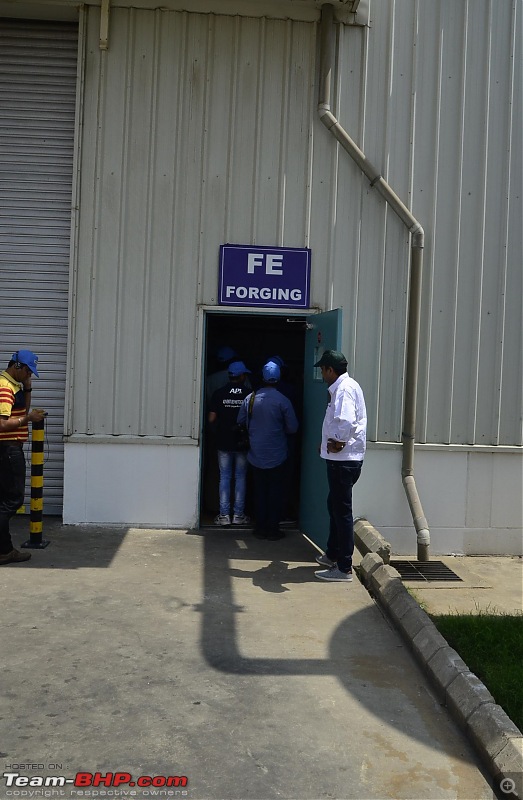 Forging area is housed inside a dedicated building: 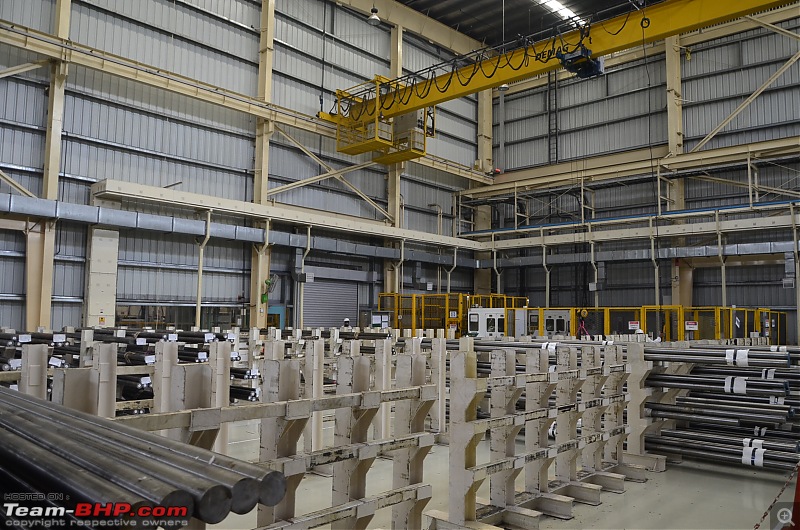 Dashboard explaining the technical process of forging equipment/s: 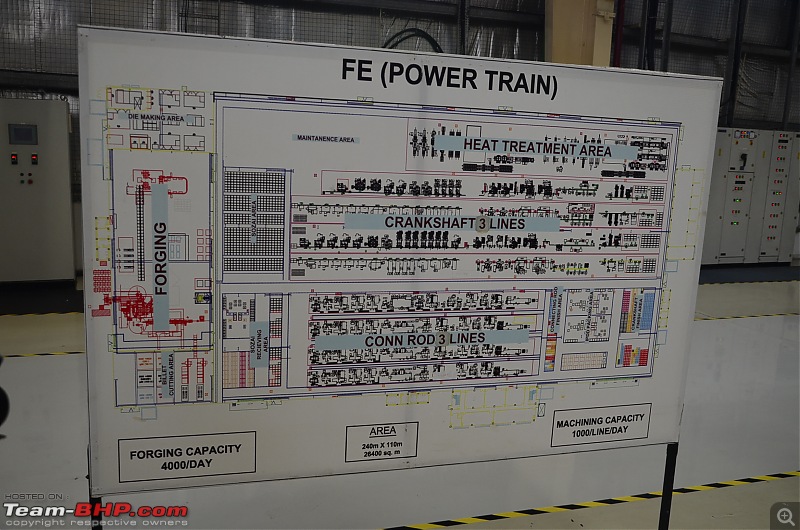 This is the first raw material in the car making process - Steel billets / rods: 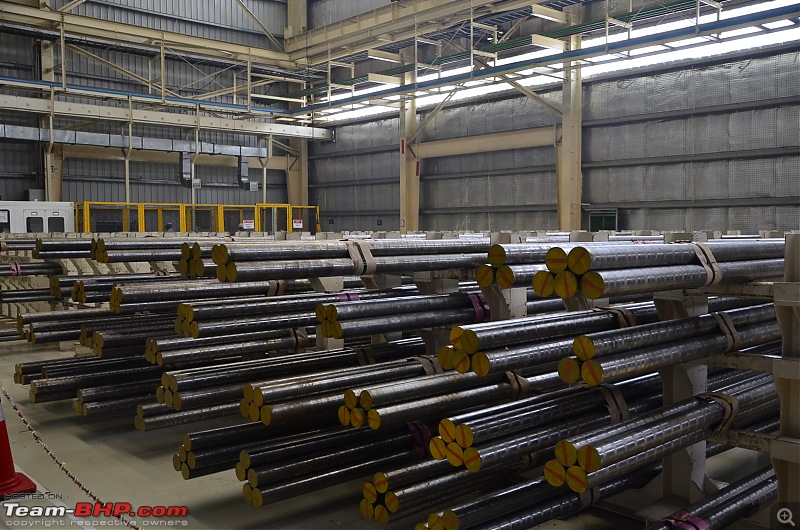 Robots pressing (Forging) the steel billets: 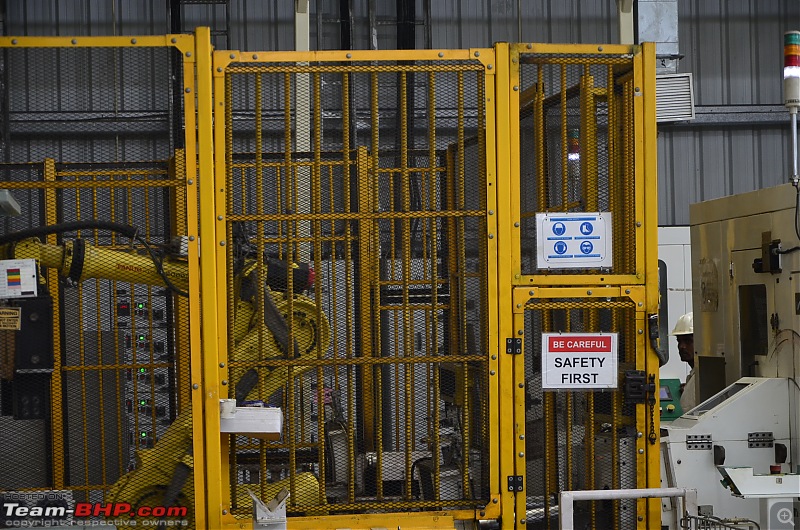 The hot furnace where the steel billets are hammered with forces up to 1,000-4,500 tons and subjected to >1200 degree Celsius temperatures to get the desired shape: 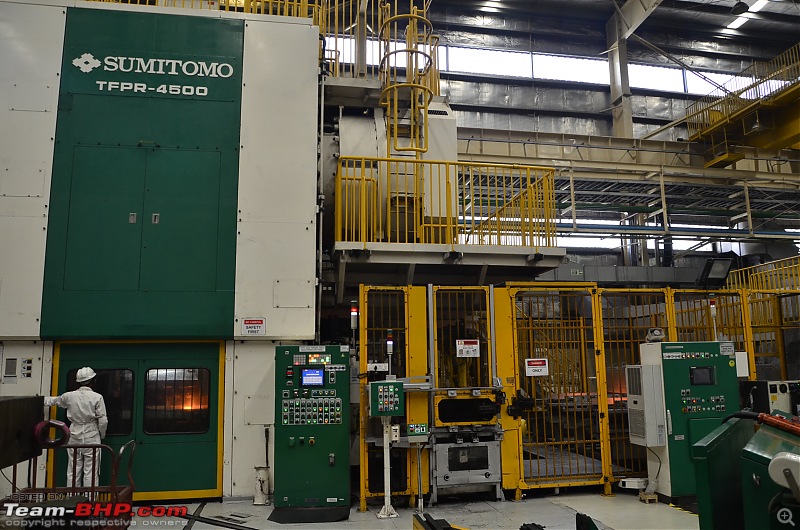 Close-up view of the hot furnace: 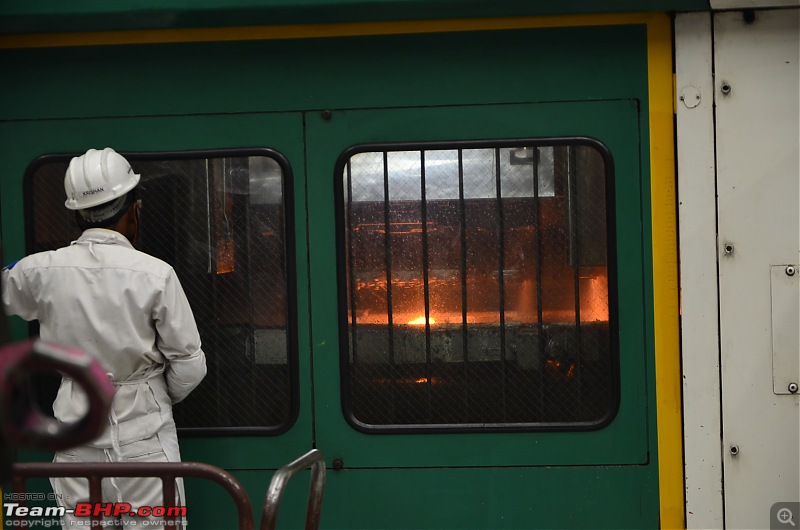 Another angle of the same procedure: 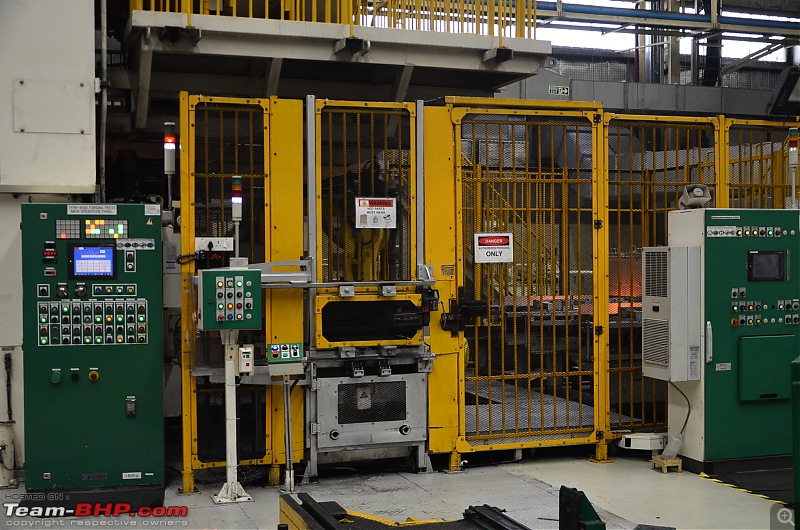 These rough metal pieces show the stages of the forging process: 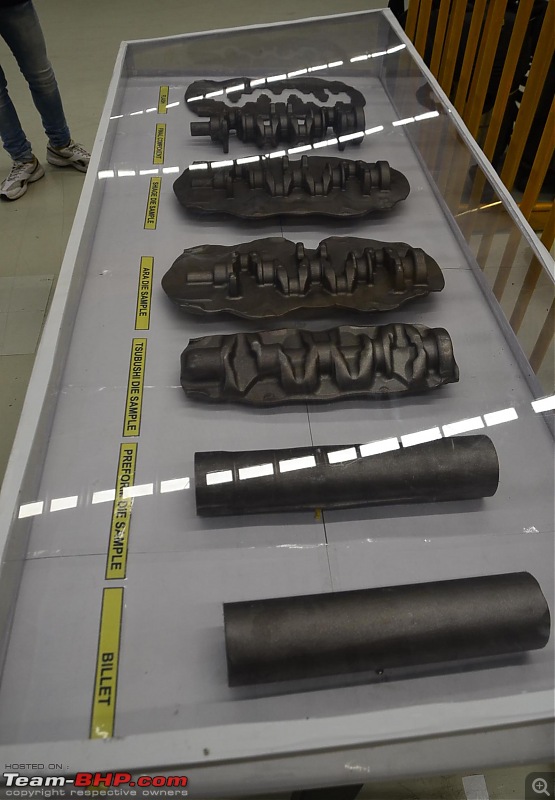 The crankshaft starts of as a billet (extreme right) and and is pressed into shape. Finally the excess material is trimmed off (extreme left): 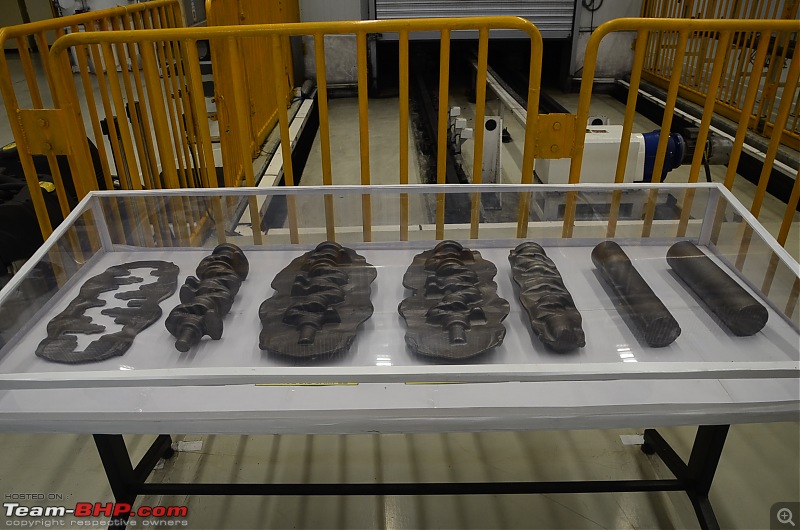 Here's what the forging dies (moulds) used to shape the metal into a crankshaft look like: 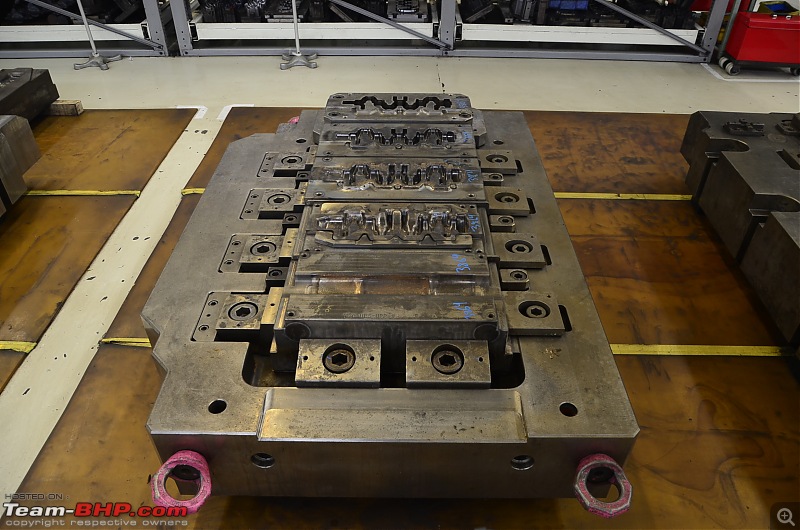 Brief video of the forging process @ Tapukara: Quality check in process: 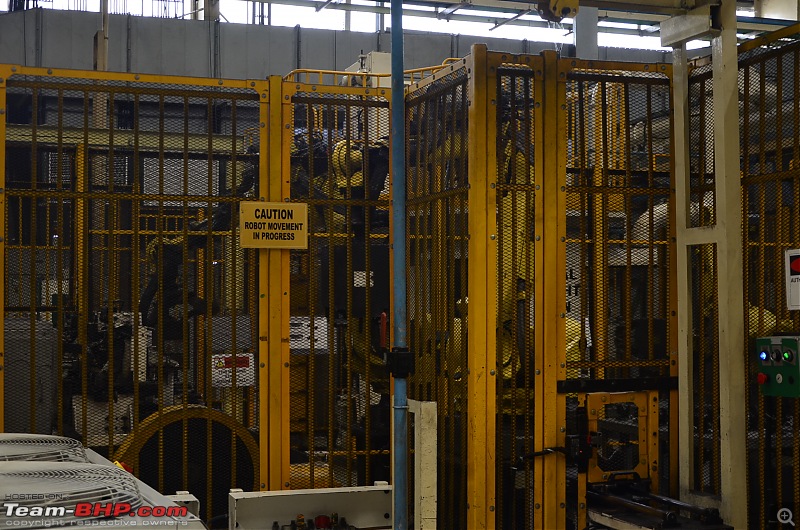 The assembly line where workers check each of the forged pieces before sending them to the next station: 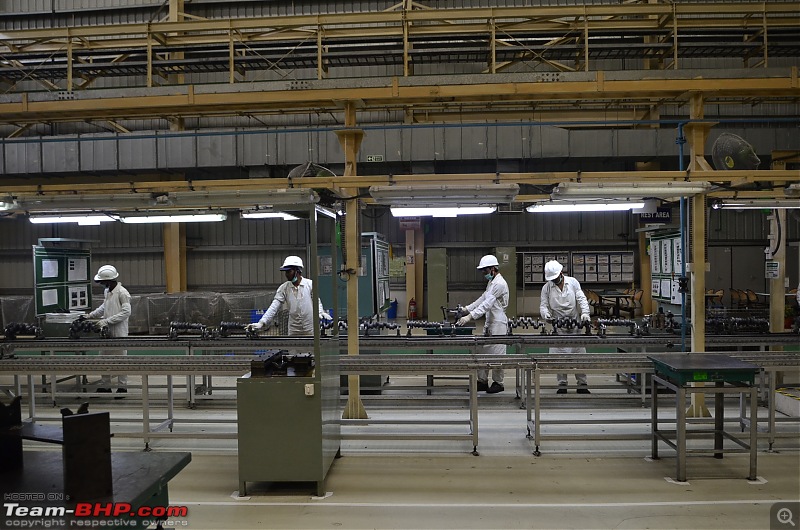 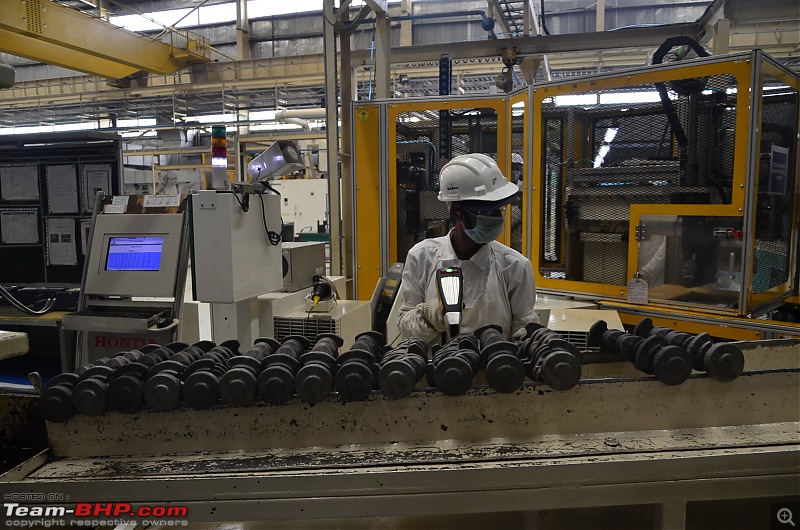 A look at the connecting rod assembly line 1 (they have multiple lines for concurrent activities): 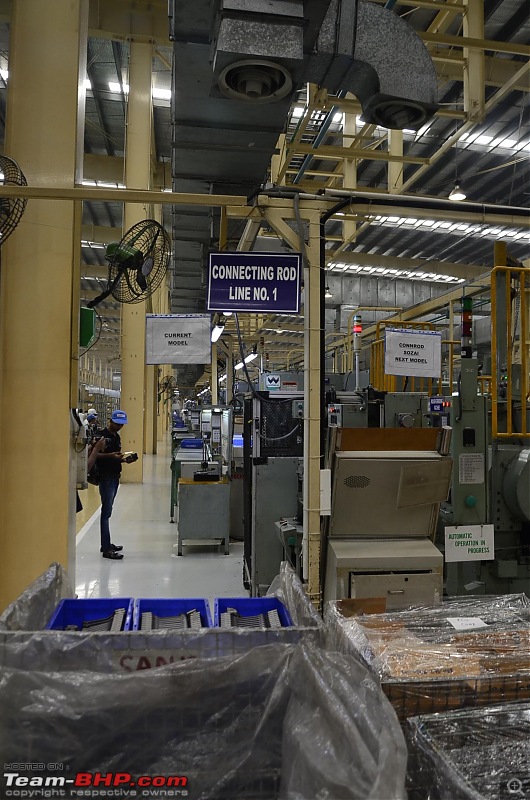 Last edited by Aditya : 5th September 2017 at 15:28. |
| |  (29)
Thanks (29)
Thanks
 |
| The following 29 BHPians Thank mobike008 for this useful post: | Aditya, aeroamit, aniket17, anilntny, anshumandun, BlackPearl, blackwasp, CarguyNish, carrazy, dailydriver, Fraz33r, GTO, Haroon, Jaggu, libranof1987, Nohonking, phoenixash, RavenAvi, Rehaan, samabhi, shipnil, Simhi, skchettry, SmartCat, The Rationalist, theexperthand, timuseravan, Turbanator, vaasu |
| | #5 |
| Distinguished - BHPian  | Machining This post gives a brief glimpse of how the crankshaft and connecting rods are fitted to the engine besides the process of machining these components. Once the forging process is over, the crankshaft is formed into its shape and then sent over for the next process in line - machining! Machining is a process where the crude outputs of forging - the crankshafts with their rough edges - are sent off on a conveyor to be CNC-machined, so that the metal is smoothened out to give it a better surface finish and a smoother profile. While the crankshafts undergo both the forging and machining processes at this facility, the company procures raw-forged connecting rods from its vendors and machines them in-house, right adjacent to the crankshaft area, bringing them into their final shape. These machines receive the forged metal and machine them to a fine + smooth piece: 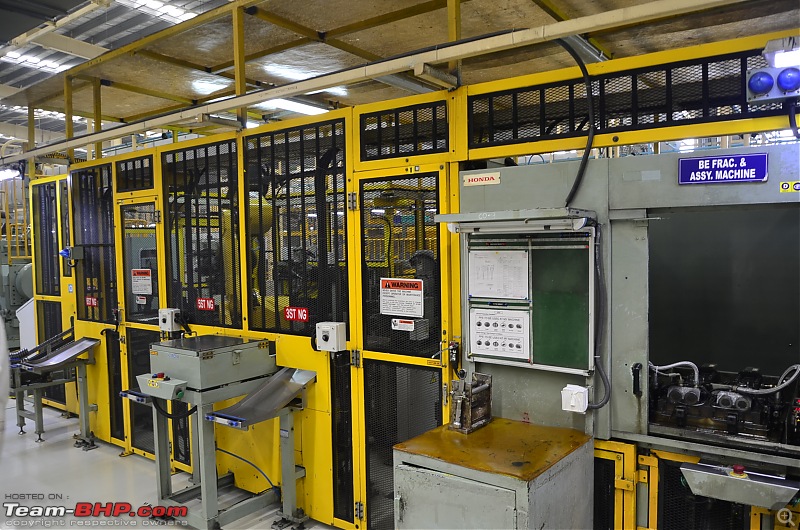 A worker displaying the finished product: 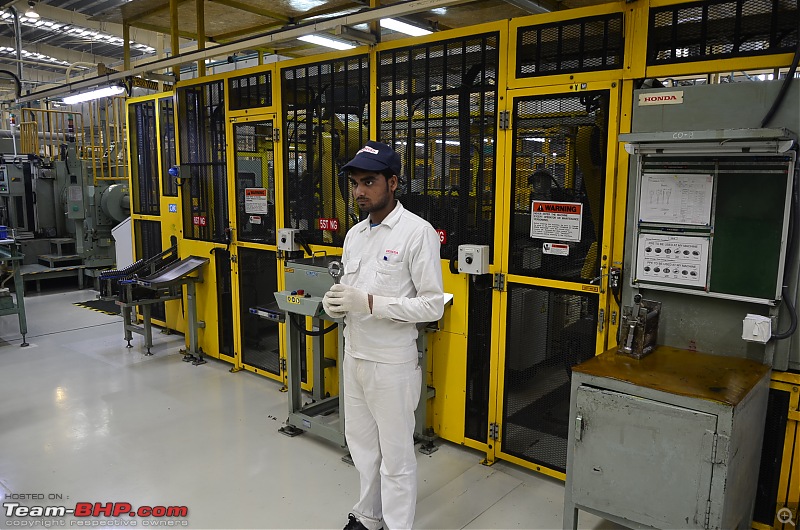 These metal pieces go through different sets of machines to complete the machining process: 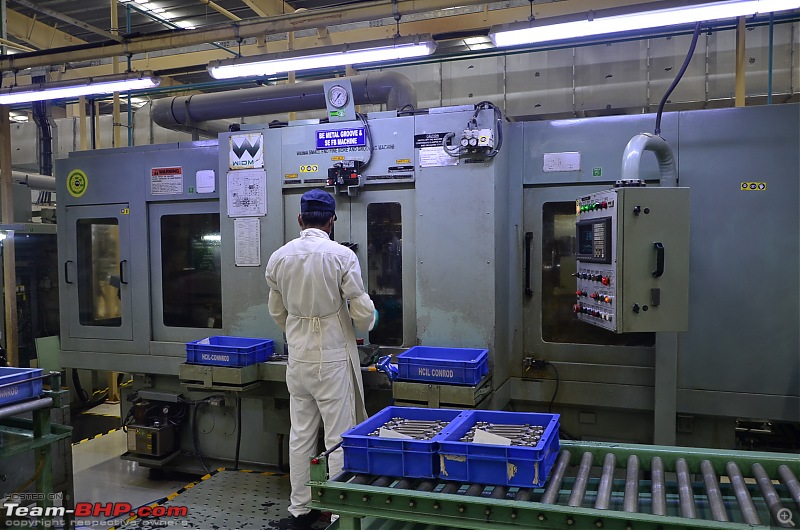 This space is dedicated to machining, which is within the part of the forging building, but in a different section with storage capacity (as seen in the picture): 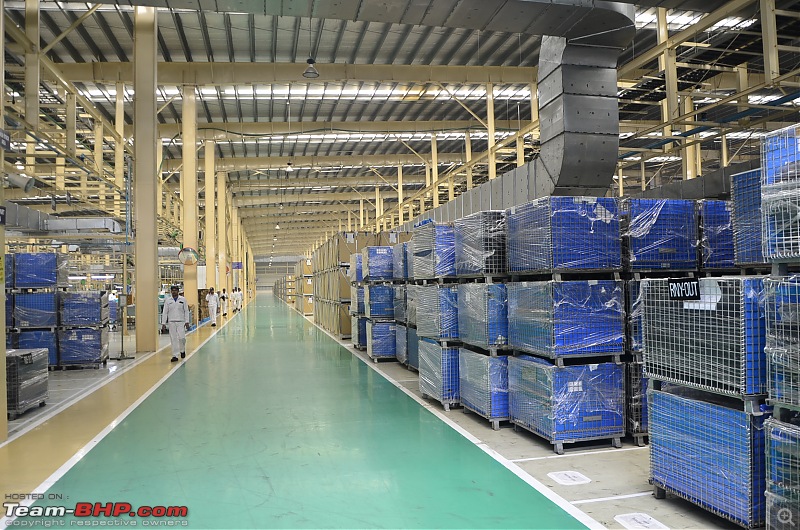 One more view of the machines used for this process: 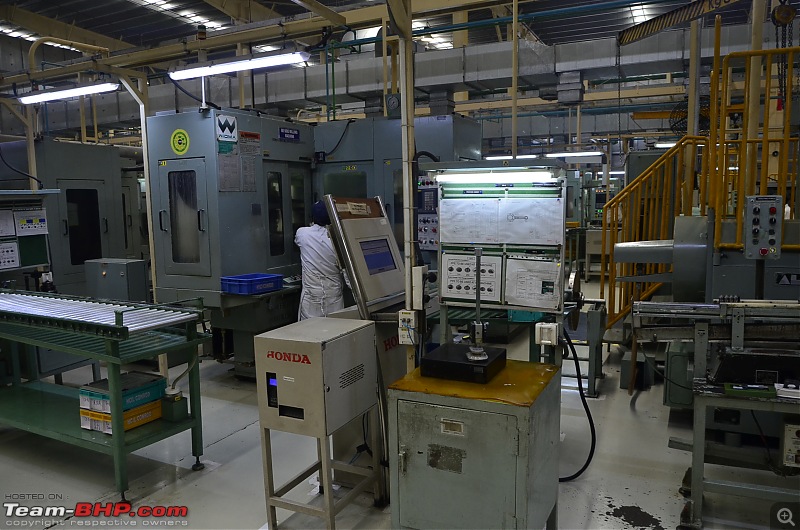 Cut-off section of the engine block with the crankshaft fitted: 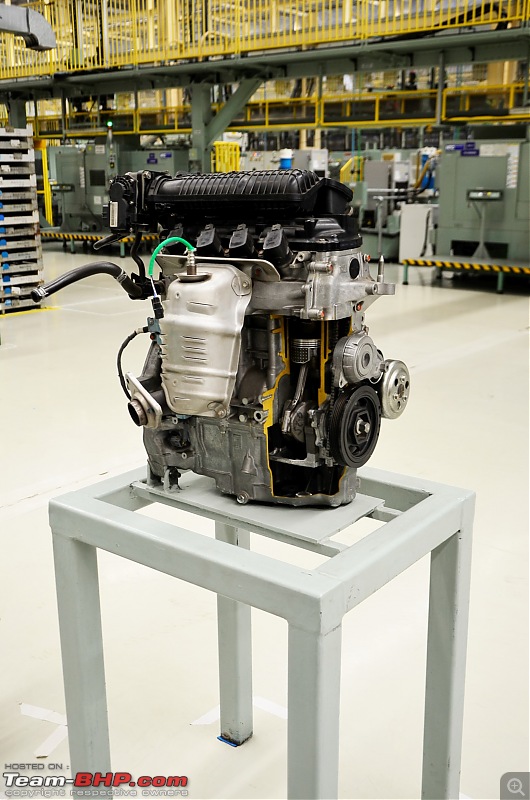 The robots in action: Another view of the forging process where the robots play a major role: Last edited by Aditya : 4th September 2017 at 10:41. |
| |  (27)
Thanks (27)
Thanks
 |
| The following 27 BHPians Thank mobike008 for this useful post: | Aditya, aeroamit, Alfresco, aniket17, anshumandun, BlackPearl, blackwasp, CarguyNish, carrazy, gostel, grkonweb, GTO, Jaggu, Leoshashi, libranof1987, Nohonking, phoenixash, punterccrx8s, RavenAvi, Rehaan, samabhi, sdp1975, shipnil, skchettry, The Rationalist, theexperthand, uday.ere |
| | #6 |
| Distinguished - BHPian  | The Aluminium Parts Section After the above processes are completed in the Ferrous section, comes one of the most important sections in drivetrain manufacturing. Here, some of the core components of the engine are built using die casting moulds. Components that are made using die casting at the Tapukara plant are: Engine Blocks Cylinder Heads Transmission Casings - Normally most manufacturers source transmissions from 3rd parties or from different manufacturers. Die casting is a process where complex shaped metal parts are made using re-usable moulds. Metals like aluminium are melted in a hot furnace and injected into the pre-moulded casts, to get a part of the desired shape. Layman explanation of die casting - Making ice cubes from an ice-cube tray, by pouring in liquid water and freezing it to take the desired shape. The aluminium section forms the foundation of it all, at least in Honda! Honda uses all-aluminium engines, including the block and cylinder head, in its entire product range globally. This is how they have been able to keep the engines lightweight. In fact, so much for the love of this metal that the super noisy i-DTEC diesel also uses an aluminium block, so as to remain lean, albeit at the cost of high operating noise levels. There are 3 die casting methods- High Pressure Die Casting (HPDC) Low Pressure Die Casting (LPDC) Sand or Spin Die Casting The Tapukara plant is utilising the above production methods to come up with these major engine parts on its own. The HPDC and LPDC jointly can belt out 1,200 engine blocks and cylinder heads per day, with the heads then needing to be sent through a spin casting process, which drills holes into the surface of the cylinder head, to make space for the engine valves and springs. We spent around 15 minutes at each of these three processes, where we were given a quick update about what the process is all about and how it fits into the entire manufacturing process. Thankfully, since our guided tour was in a proper sequence, I was able to recall all the key points that were explained to us by the tour guide, who was one of the senior plant managers at Tapukara. After taking a deep breath and sinking in the stuff learnt until now, we moved over to the next building. As mentioned earlier, the shops in Tapukara are in a sequence and close to each other, with enough road separation in between, for quicker transition of components from the previous process. Aluminium and die casting: 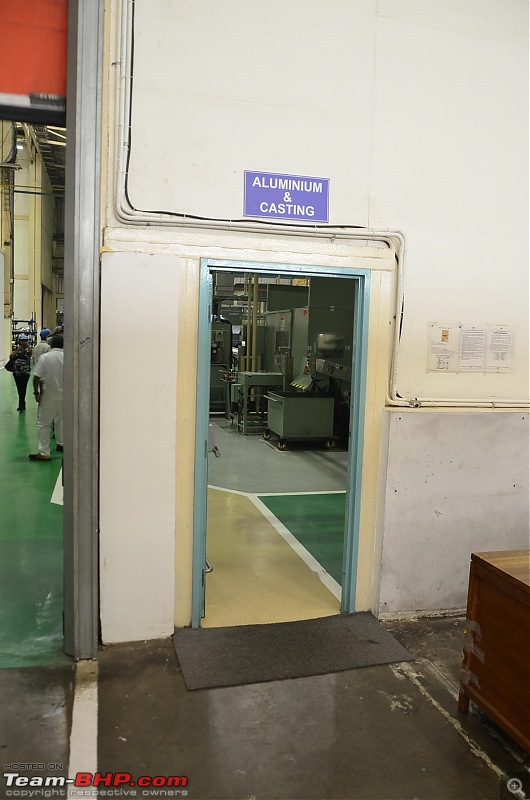 Dashboard giving a technical layout of the process: 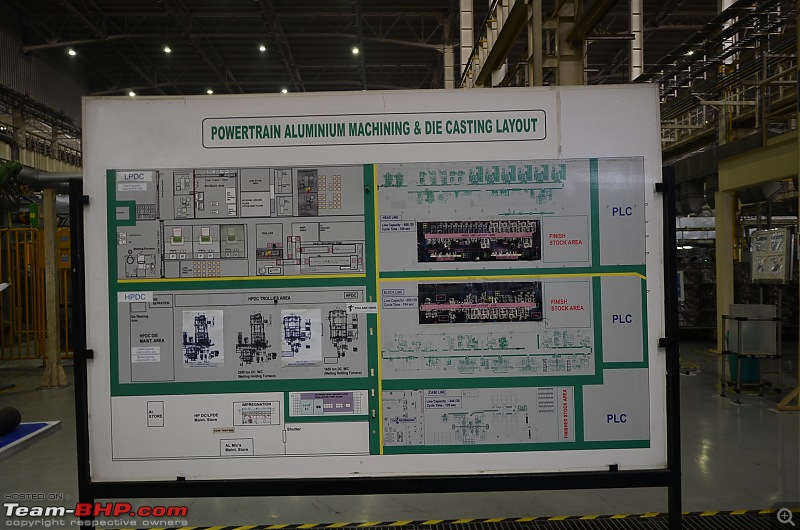 Head of this section giving us the basics of die casting: 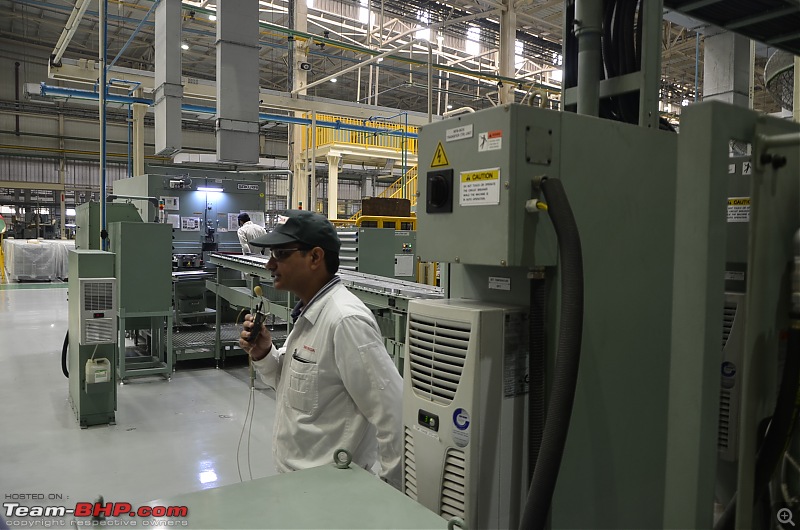 Assembly line of the die casting process: 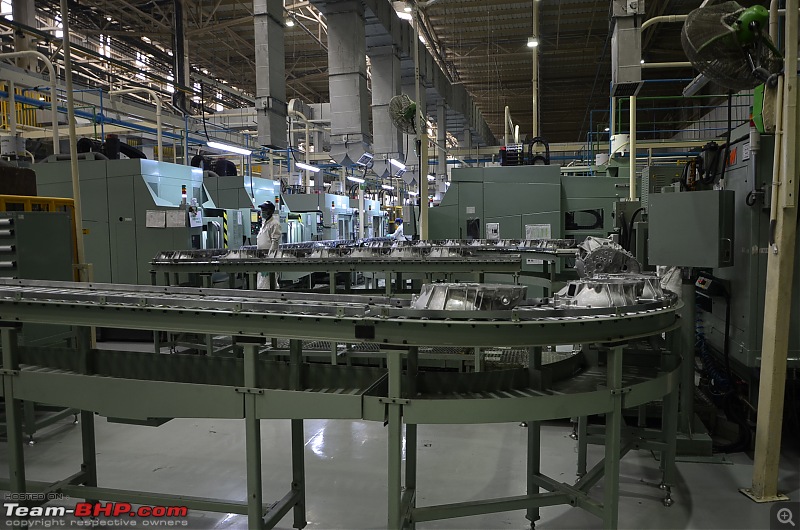 Die casts made and stored in racks: 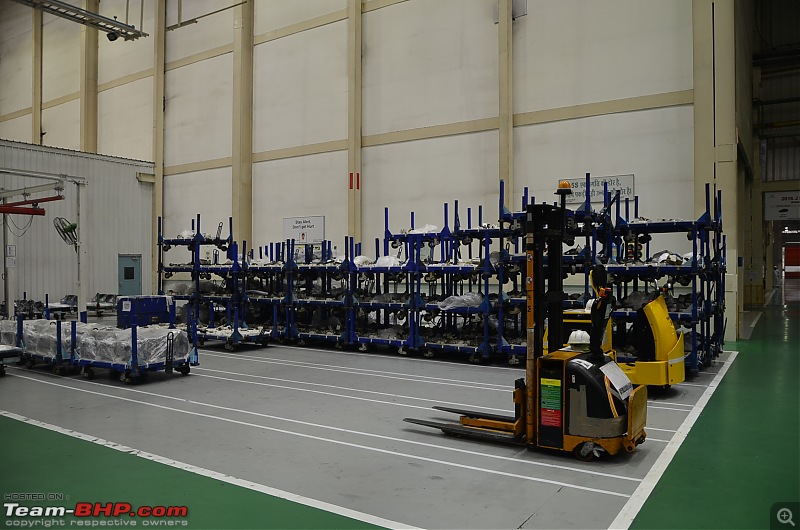 A closer look: 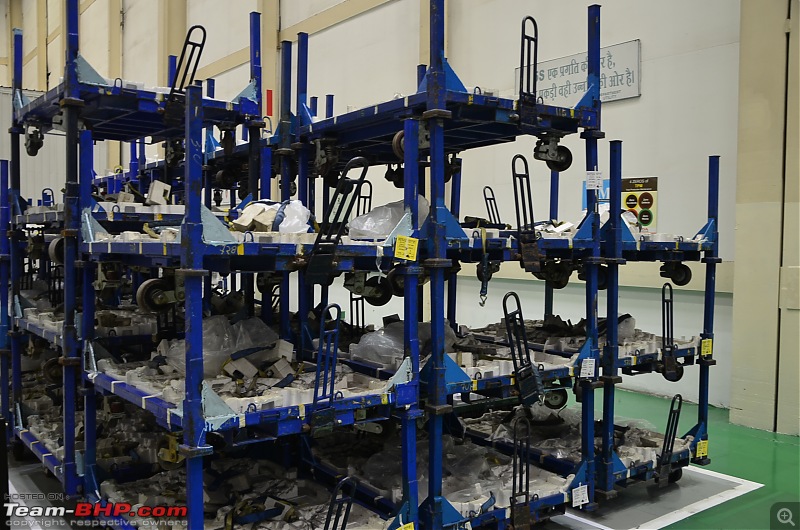 Aluminium machining cylinder block line: 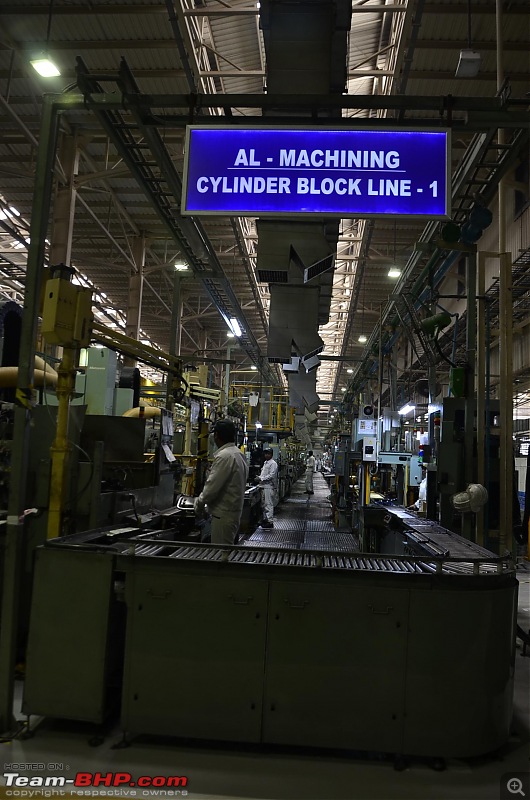 Machined and die casted blocks: 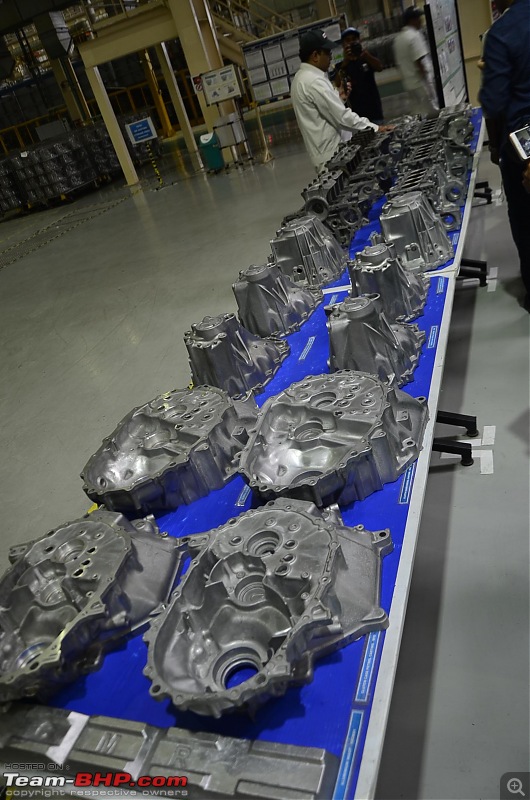 Die casted pieces: 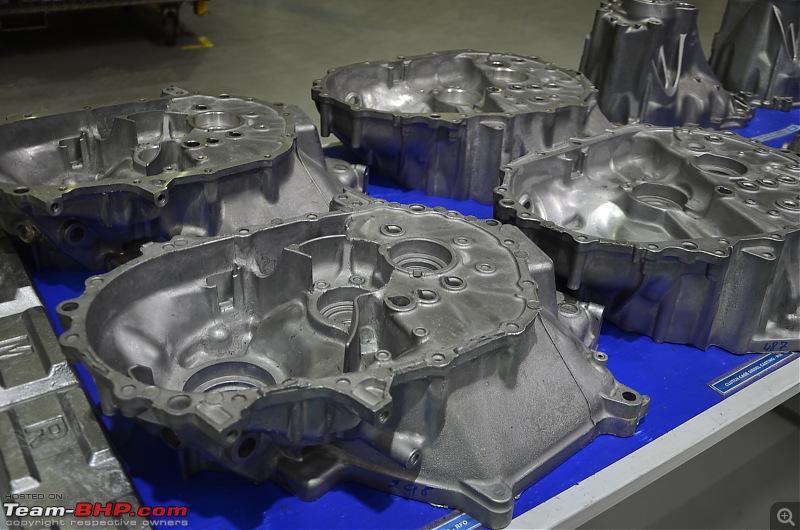 Die casted blocks nicely lined up: 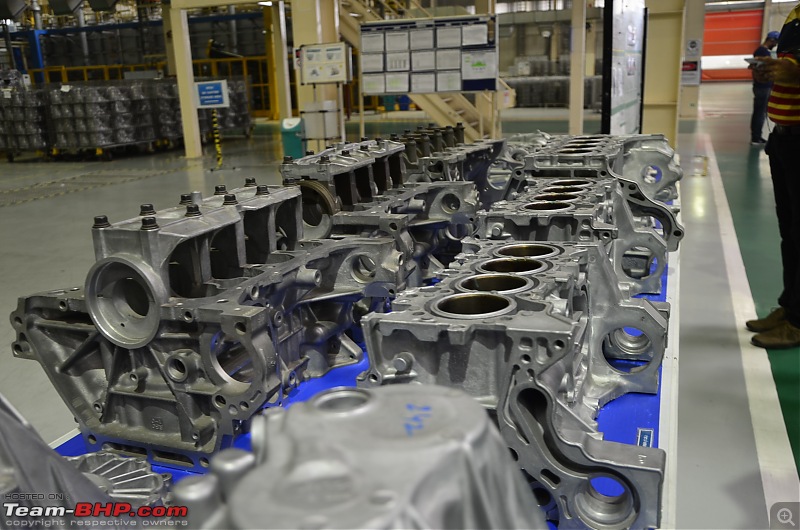 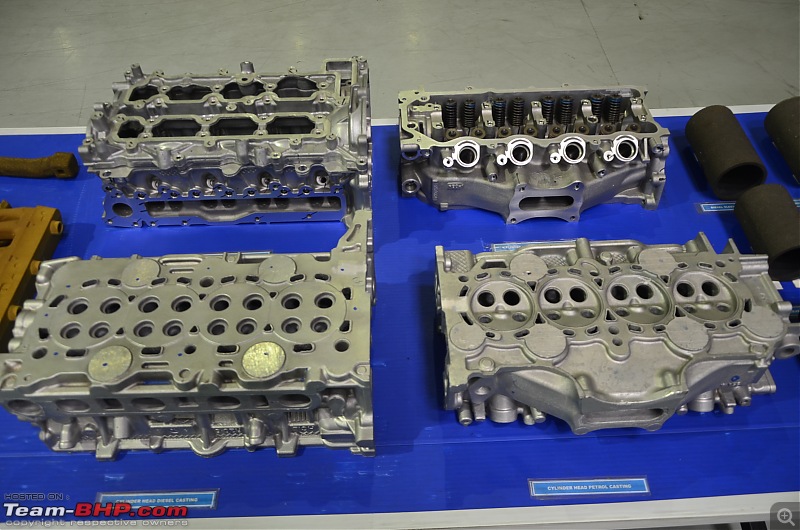 Safety guidance is of utmost importance in a plant. This section mandated wearing helmets. Some areas do and some don't: 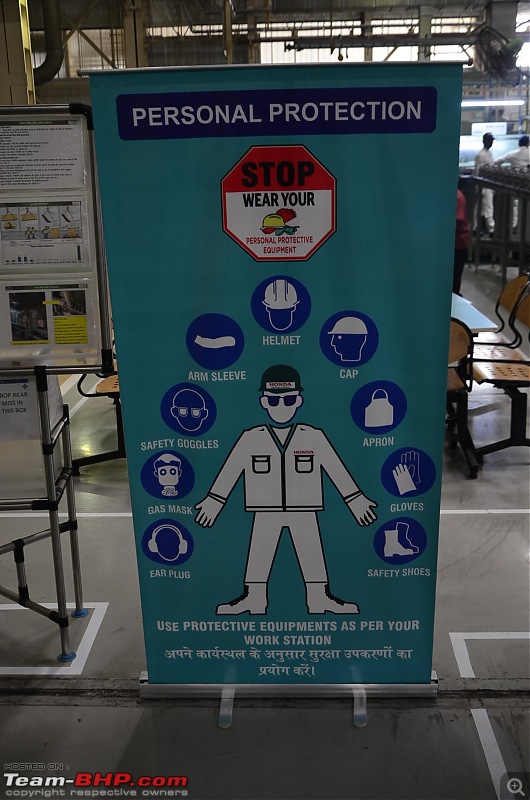 Assembly line view: 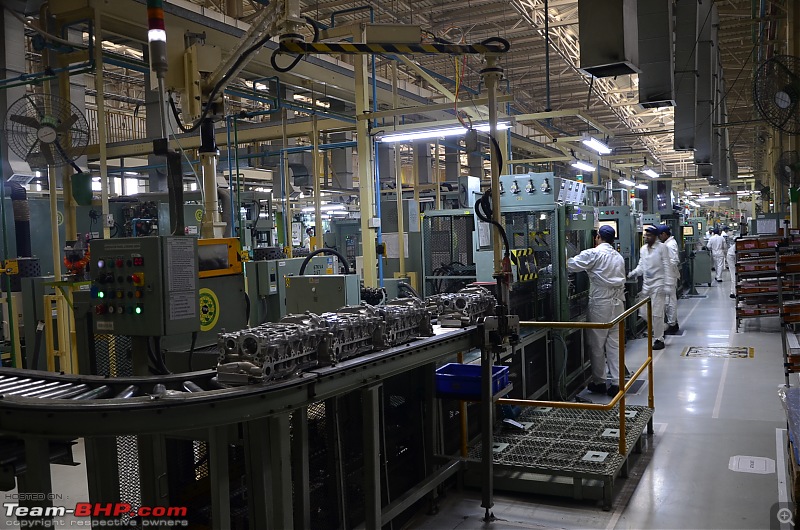 Heavy-duty machines used for this process: 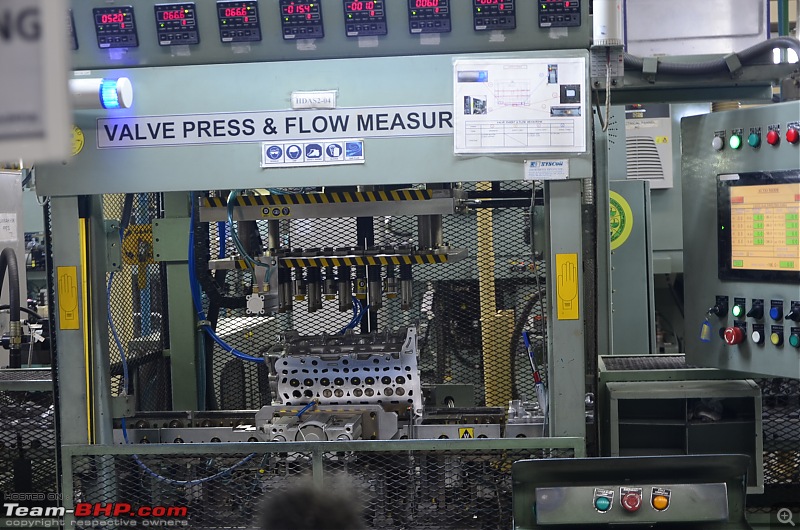 Workers putting together the final components of this stage: 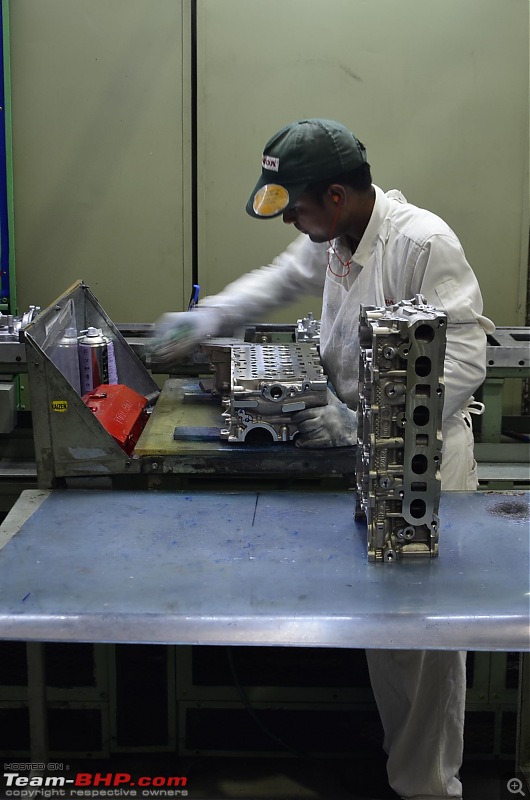 Shiny & fresh aluminium! 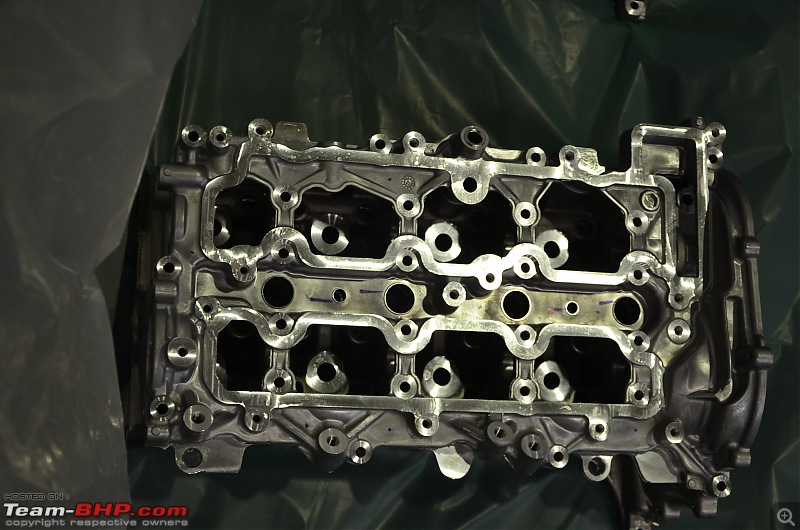 From another angle. Like all the areas, there is ample room for walking and viewing from a distance: 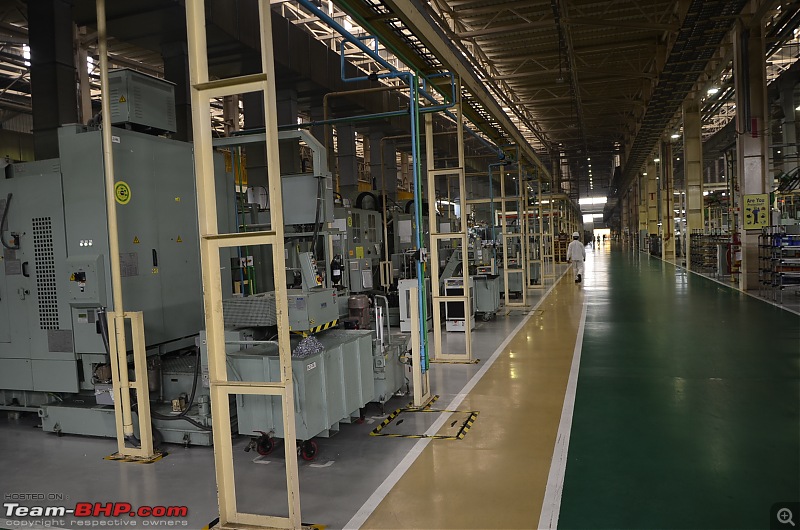 Last edited by Aditya : 4th September 2017 at 10:41. |
| |  (26)
Thanks (26)
Thanks
 |
| The following 26 BHPians Thank mobike008 for this useful post: | Aditya, aeroamit, aniket17, anshumandun, blackwasp, CarguyNish, carrazy, dailydriver, gostel, GTO, Jaggu, libranof1987, Mevtec, Nohonking, phoenixash, RavenAvi, Rehaan, samabhi, sdp1975, Simhi, skchettry, SS-Traveller, theexperthand, uday.ere, vaasu, vishy76 |
| | #7 |
| Distinguished - BHPian  | Press Shop Here, the metal parts are pressed and given shape. All the sheet metal activity to form the monocoque and exterior body panels takes place here. There are different types of pressing functions, depending upon what shape is required, or depending on the part of the metal. For example: a) Press Brake - which can bring a metal into any ‘bent shape’. And for bending strong metals, you need really high pressures to be applied to them. This is done by the pressing machines with massive capacity of pressures ranging from 1,000 tons to 1,500 tons. b) Punch Press - used for punching holes into the metal. c) Stamping press - that can help in bringing a proper shape to the metal, by deforming it with a die and then stamping it with pressure to gain the desired shape. Each of these machines work in a 3-step process: 1. Draw the shape 2. Trim it 3. Pierce it We walked over to the next section - the Press Shop: 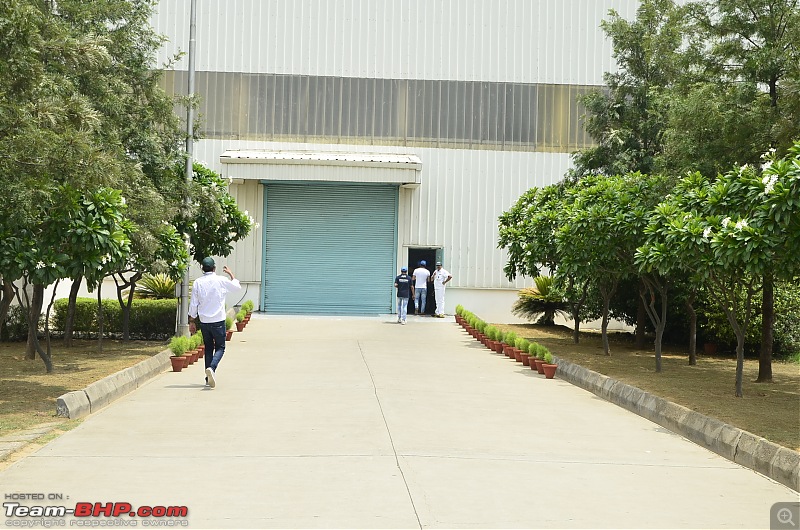 The entrance: 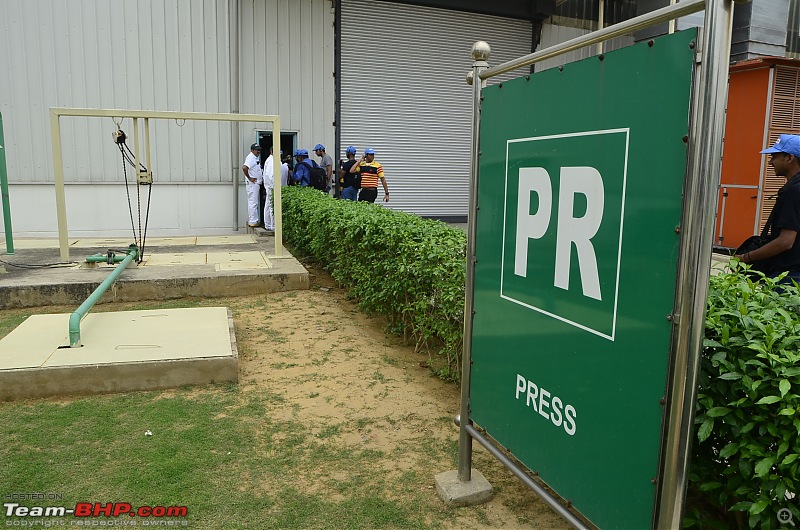 Powertrain department: 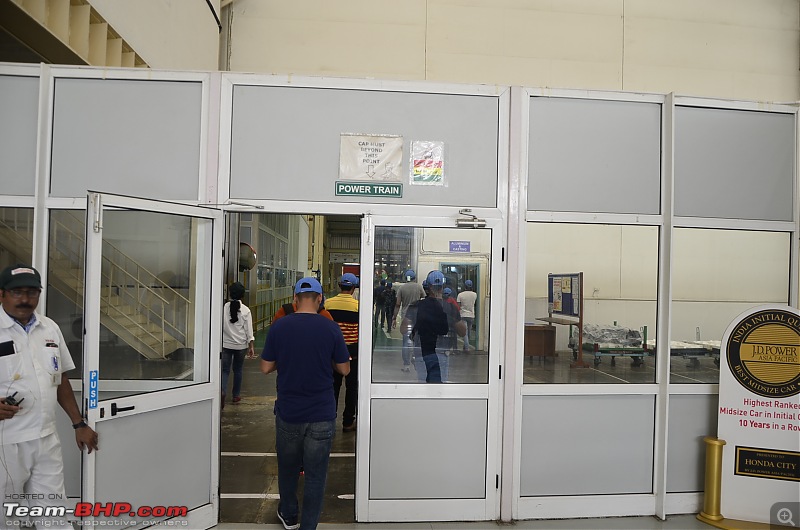 Head of the press shop explaining the layout to us: 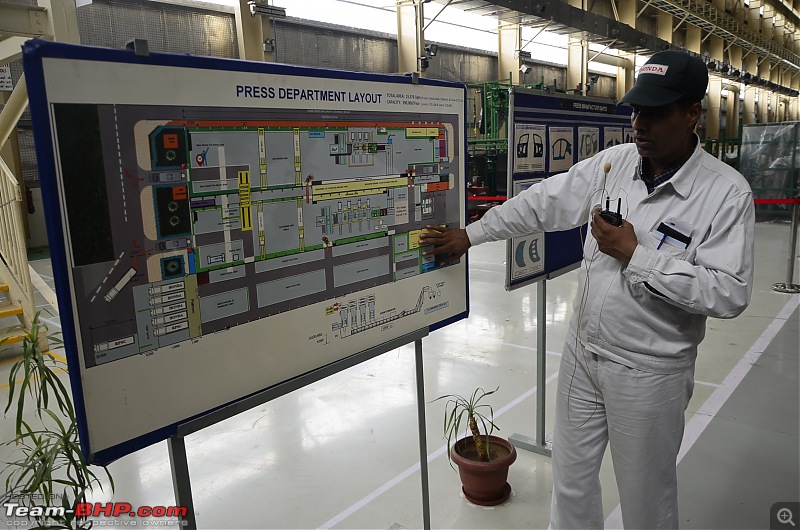 Dashboard highlighting the section's layout: 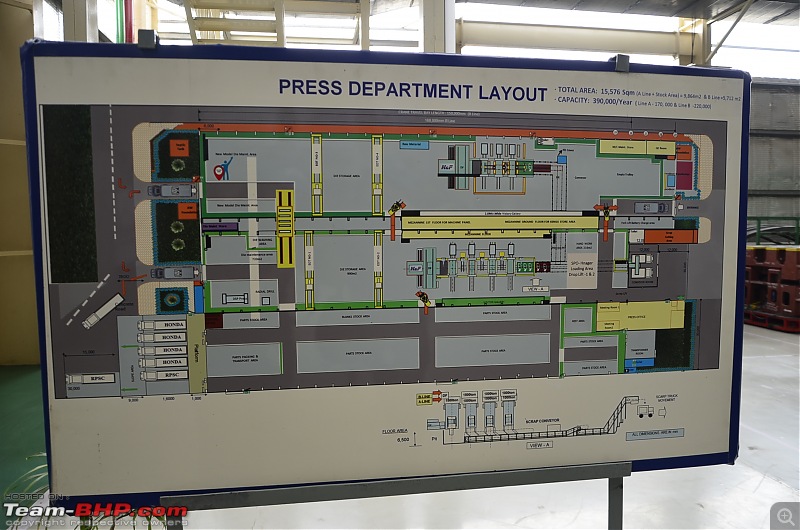 Outlining the different parts of a car that undergo the "Press" process: 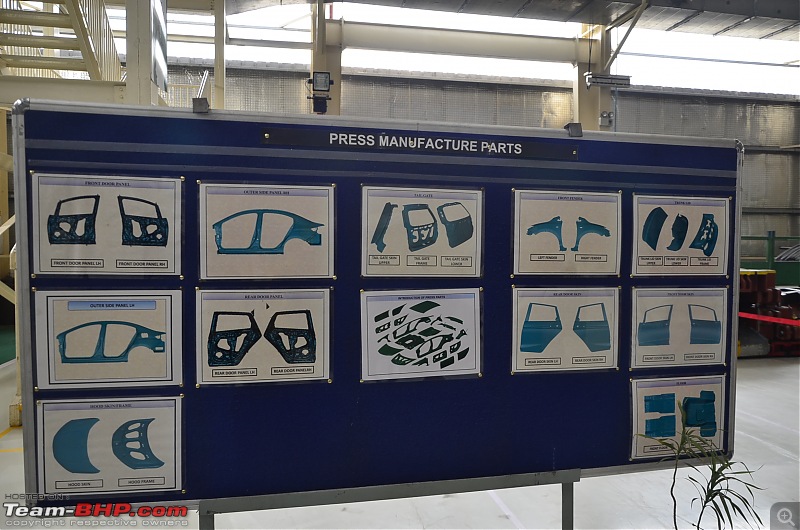 The gigantic press machines: 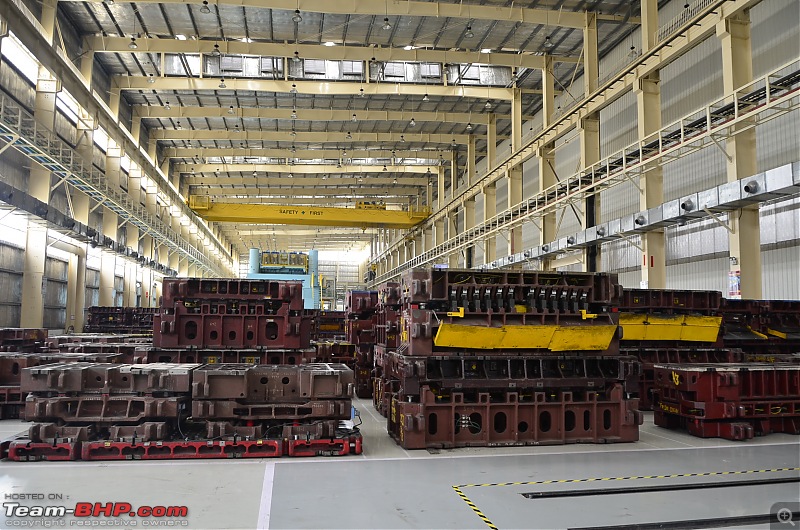 Close up view of what the press does: 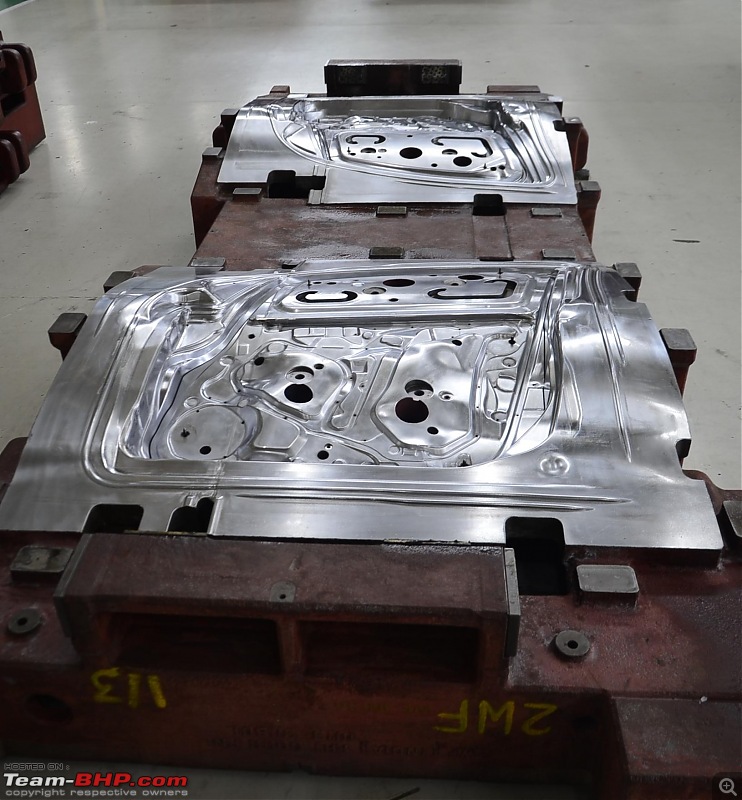 Another look: 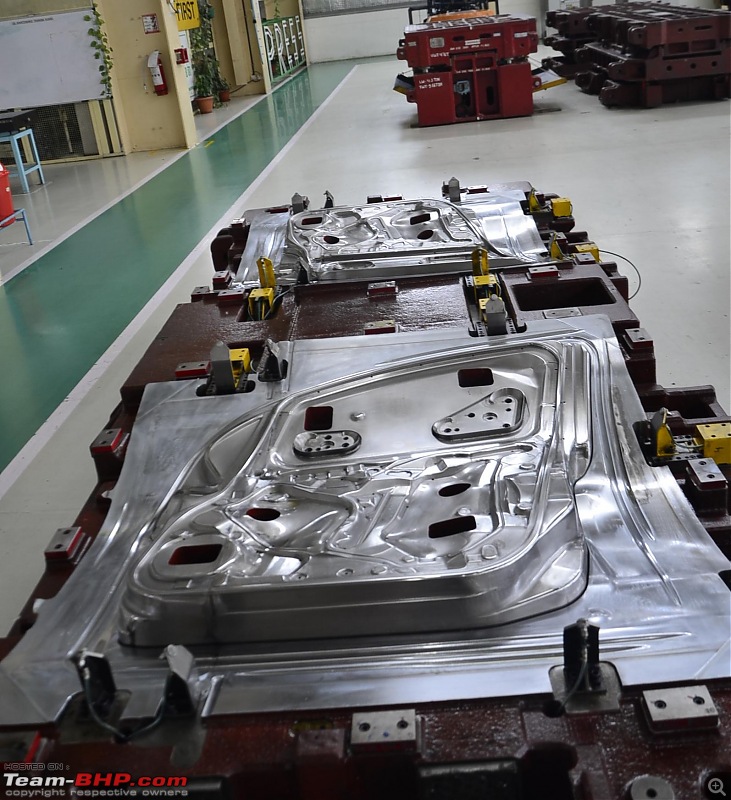 A look at the facilities: 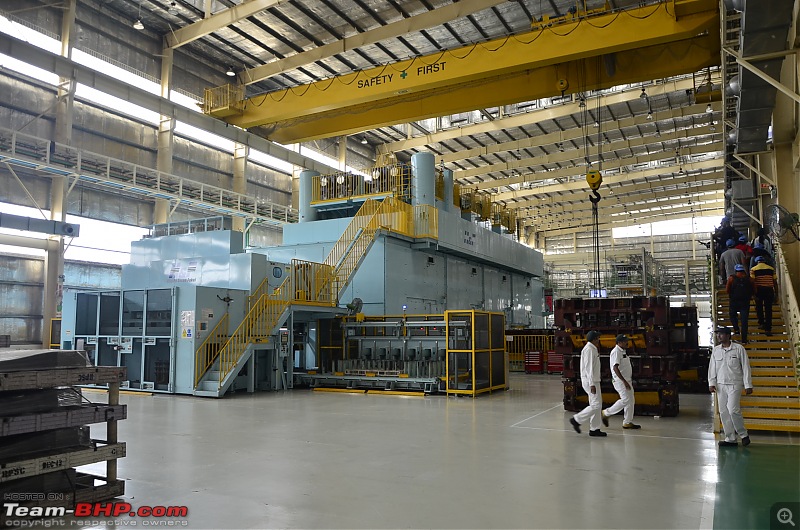 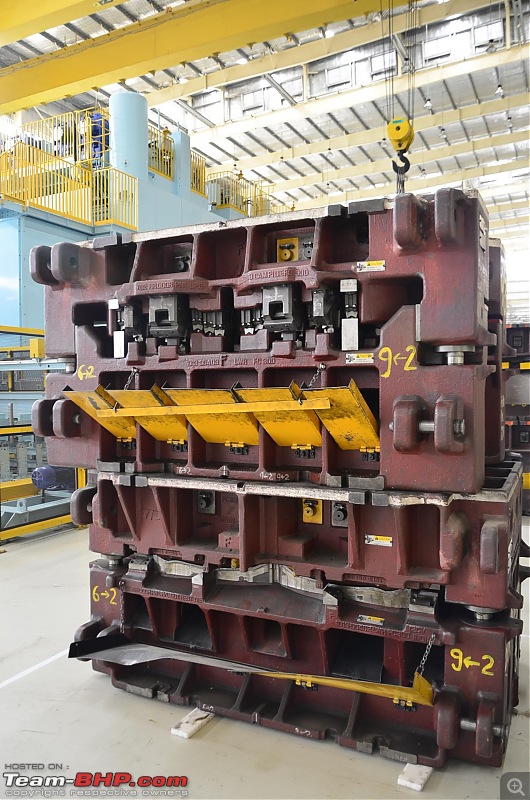 Bird's eye view of the whole activity: 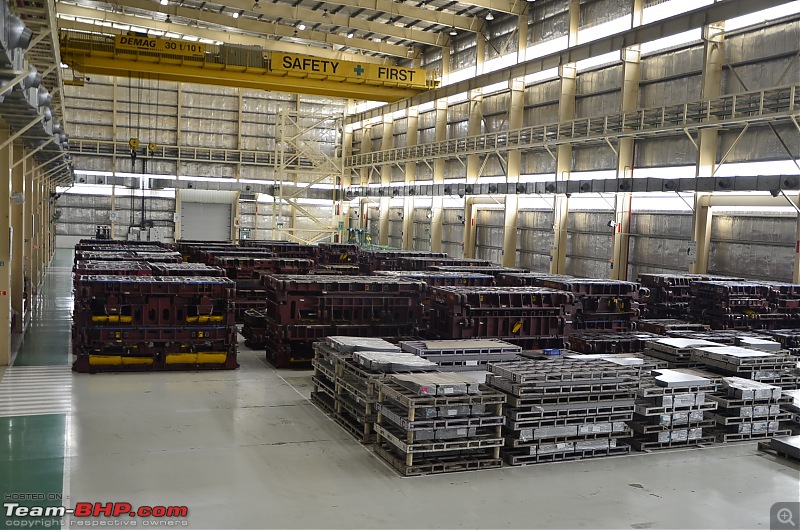 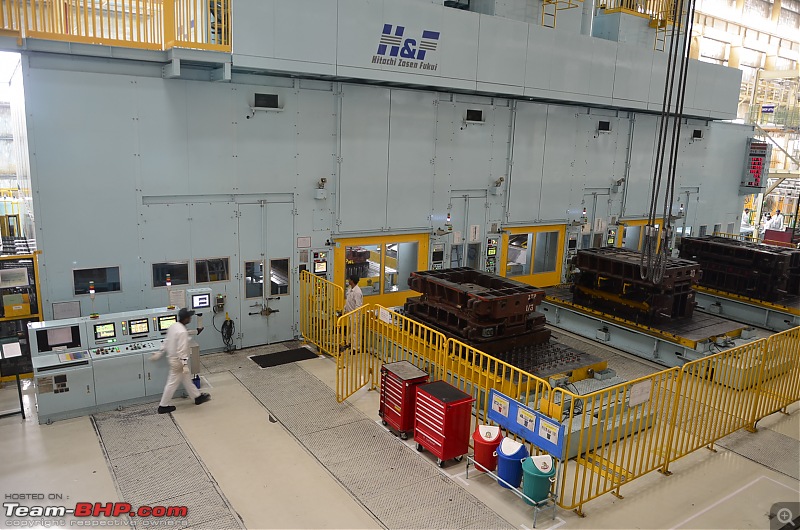 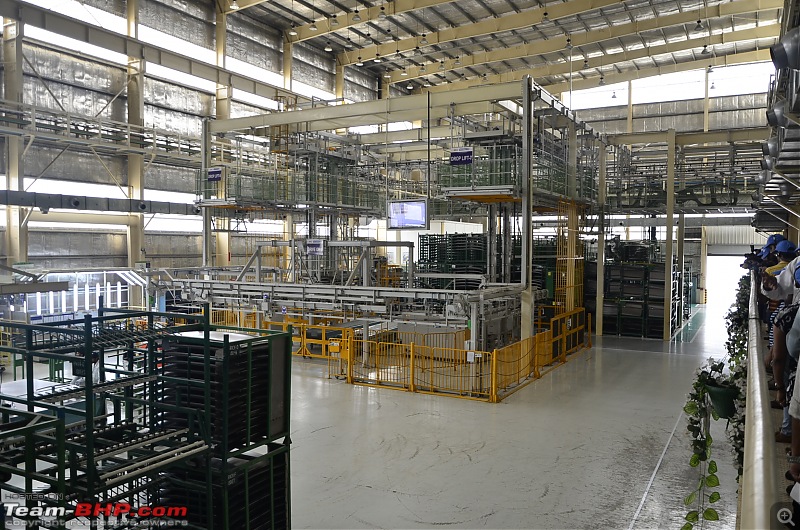 How a door panel is pressed: 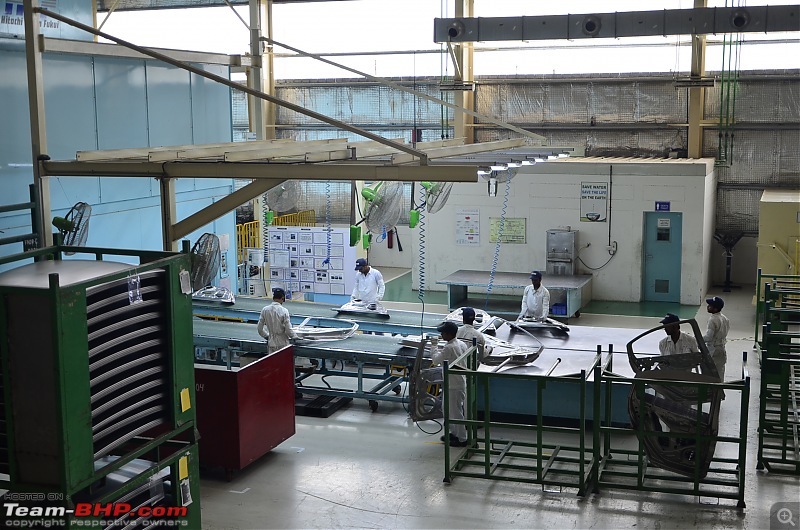 Storage of door panels that are pressed and completed: 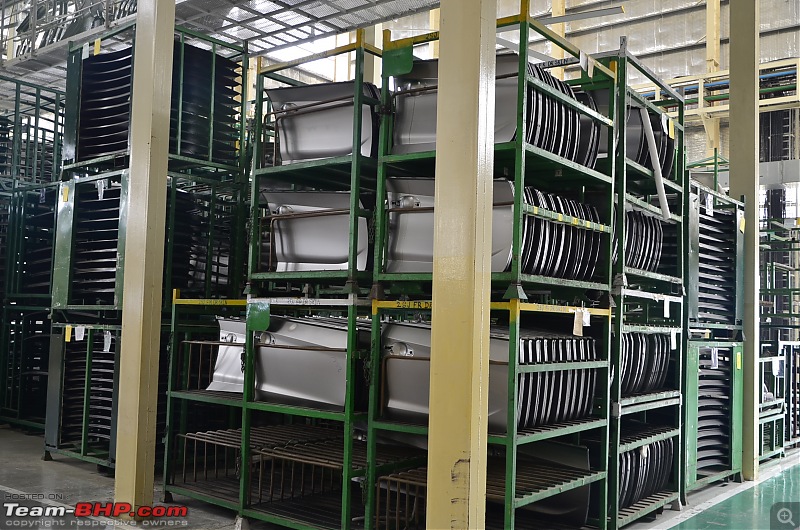 These look like spare wheel wells: 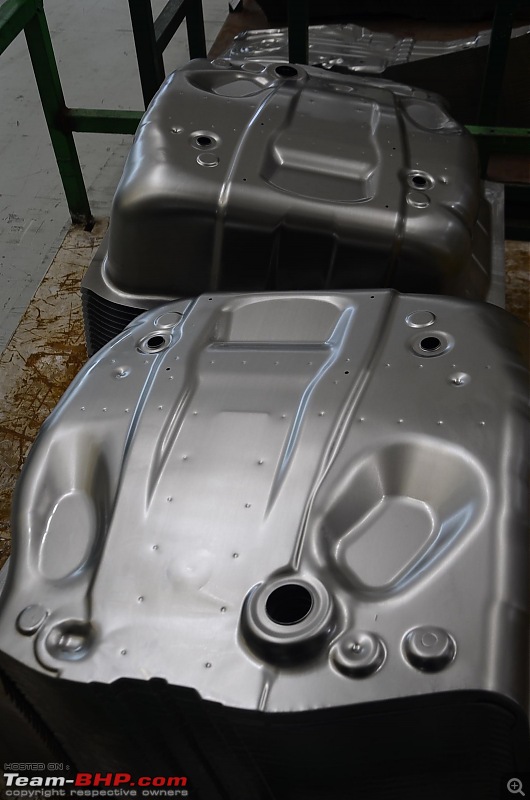 During the pressing activity, there are some parts of metal identified as scrap. A machine takes those unused metal pieces outside the shop via a conveyor belt for recycling. Last edited by GTO : 5th September 2017 at 15:21. Reason: As per RP |
| |  (25)
Thanks (25)
Thanks
 |
| The following 25 BHPians Thank mobike008 for this useful post: | aabhimanyu04, Aditya, aeroamit, aniket17, anshumandun, BlackPearl, blackwasp, CarguyNish, carrazy, daretodream, GTO, Jaggu, libranof1987, Mevtec, Nohonking, phoenixash, RavenAvi, Rehaan, samabhi, shipnil, Simhi, skchettry, SS-Traveller, theexperthand, vaasu |
| | #8 |
| Distinguished - BHPian  | Weld Shop Once we finished witnessing the press shop and saw those gigantic 1,000 - 1,500 ton machines pressing the sheet metal into recognisable parts, we were ushered into the weld shop next door. Here, we encountered multiple aisles, all divided into different zones (A, B, C and D). Each of them handles a different section of the car. Zone A: The right and left side body panels, including the fender and quarter panels are mated to the monocoque. Zone B: Has 3 jigs to hold the roof components in place. Roof arches are held below by these jigs. Then, the roof skin - which is what we see the roof to be like from the outside of a car - is welded on top of these structural supports. Variants with a sunroof get lesser, but more rigid roof arches below the skin. Zone C: It takes care of the welding of the rear and front doors, and incorporates a special process called ‘Hemming’. So, hemming actually seal-tights a skin to its structure. The hood skin and its underlying structure, the trunk skin and its structure, are welded in this zone. Zone D: This is the main conveyor line in the welding shop, which runs in the center. It takes the parts from the other three lines to assemble those on the main body to ultimately result in a final Body-in-White (BIW) of the car. Furthermore, the C zone sees the final inspection of the BIW, which is held back for any minutest errors in welding or sheet metal deformity, before it is sent to the paint shop. While spot welding is the primary methodology on a Honda, MIG welding is also used at critical sections with 6 such welding guns in place on the weld line. Paint Shop Now, this is one area where no manufacturer allows any media to have a peep inside (even our earlier factory reports had no pics of the paint shop). When I asked this question with a lot of curiosity to the Tapukara in-charges, I was told that there is no secret formula that is being guarded out there, but a simple reason why it is prohibited to enter the paint shop. It is because the paint area is to be kept extremely clean with an absolute "zero-dust" environment as even a small speck can spoil the colour mixture. Pressed panels are stored in these racks: 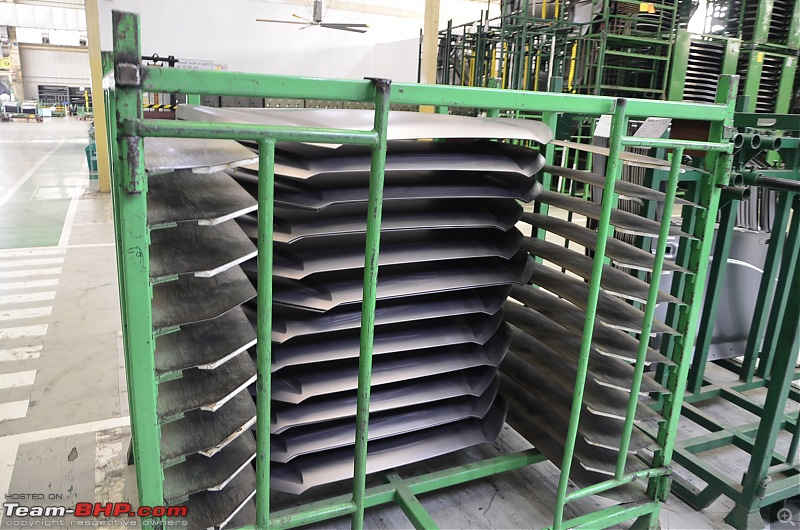 Massive rows & racks of the completed panels ready to be fitted to the car: 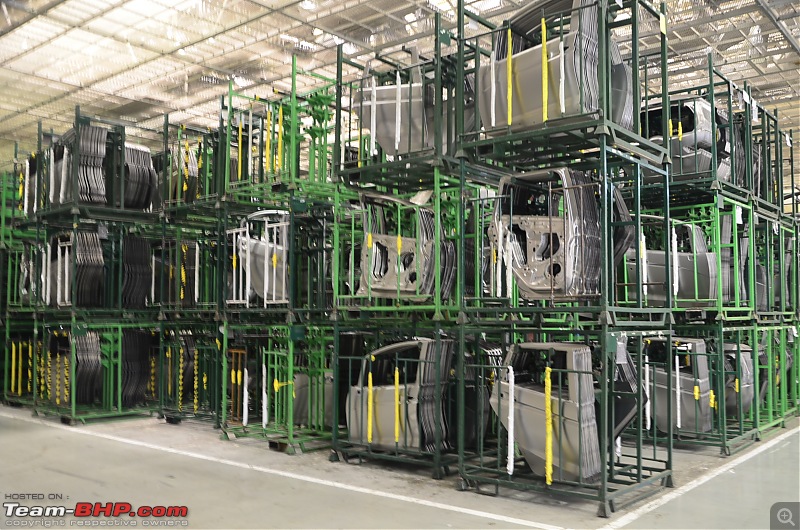 Little closer view of the work being done: 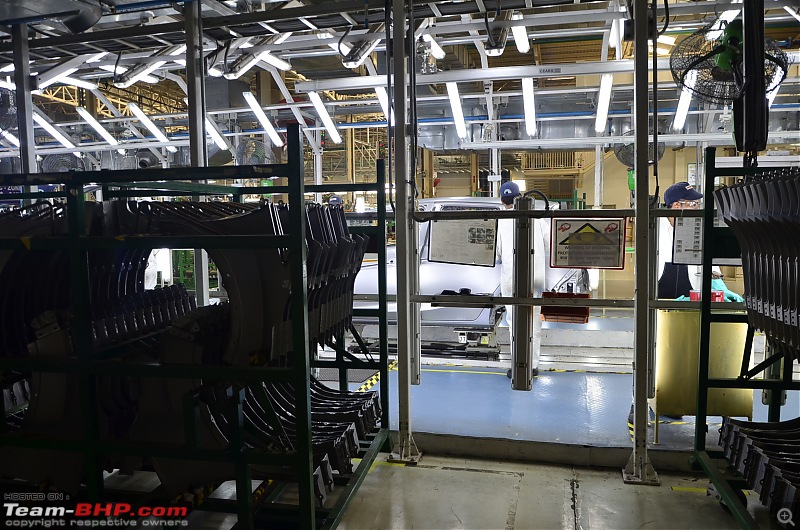 Weld area & inspections: 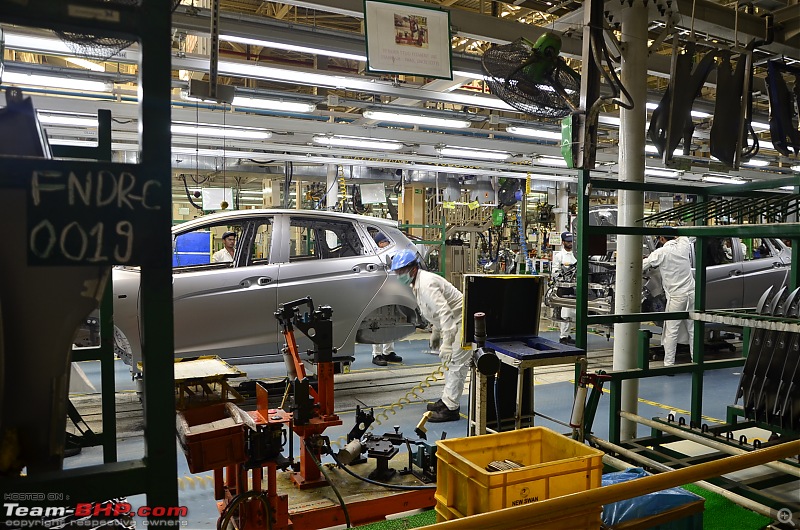 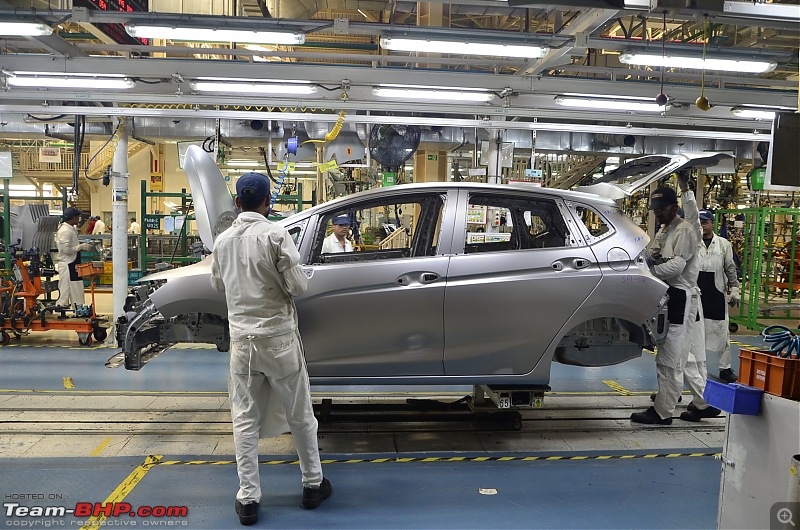 Frontal view of the cars on the assembly line: 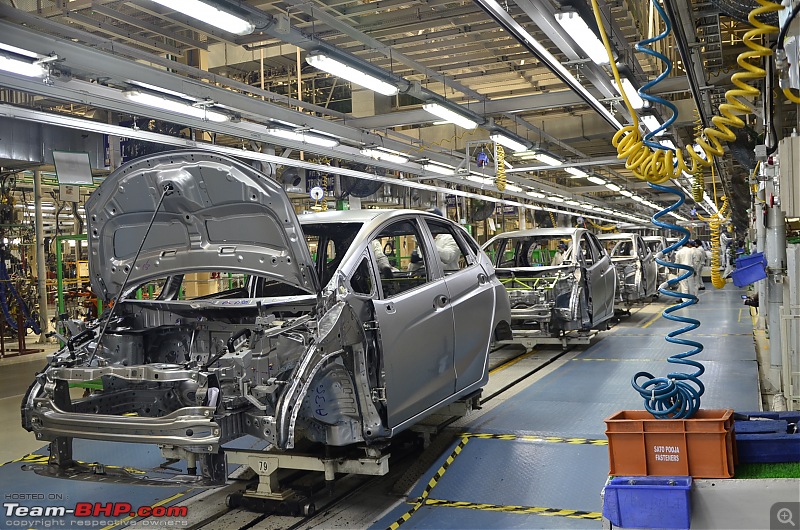 Up close: 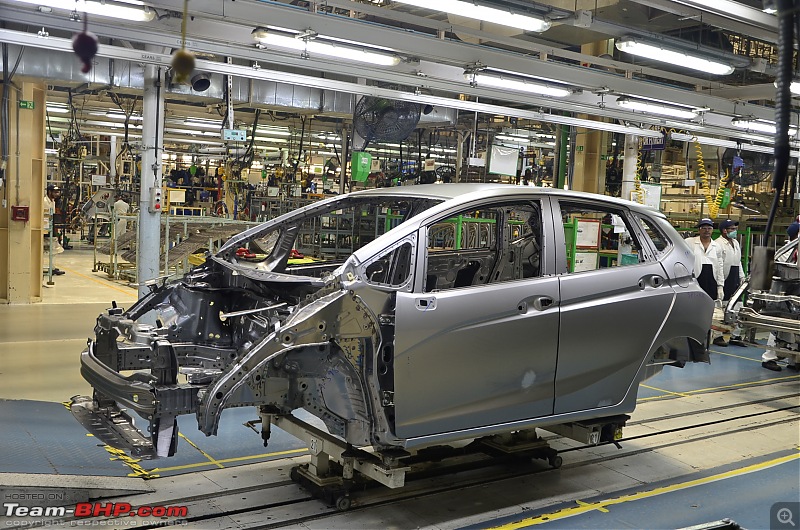 Welding work on the floor of the car to make way for the wiring which is the first step of the interior process: 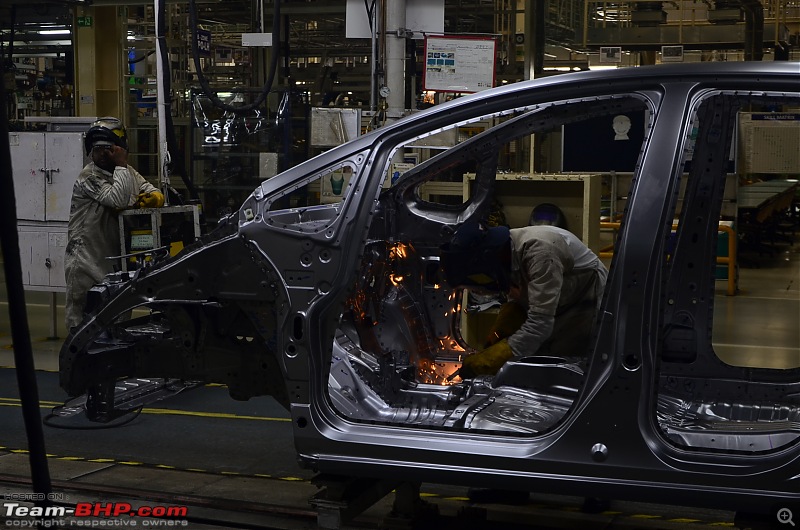 Close-up view of the empty shell where so many things must be installed before moving onto the next step: 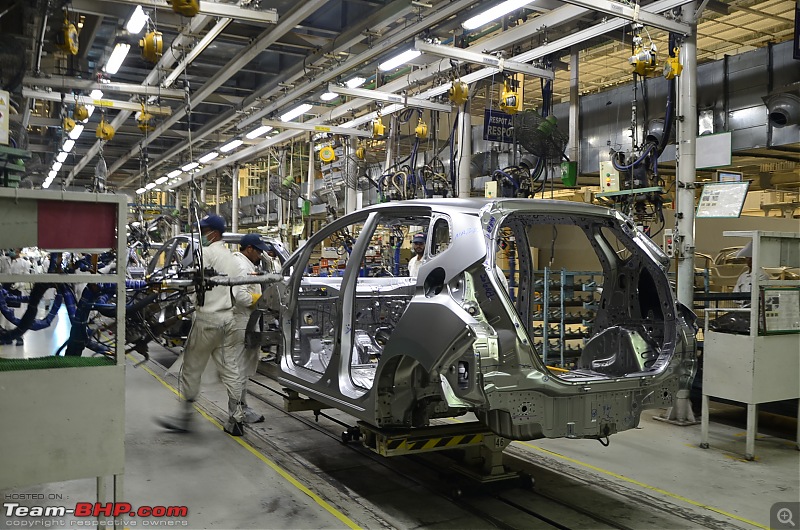 A short video of the interior paneling: Car comes on a conveyor belt from the top and passes through this narrow hallway to the welding zone: 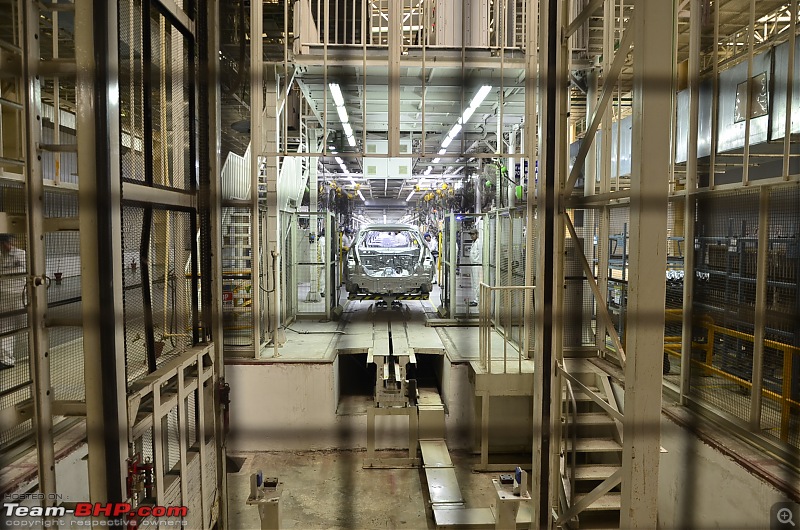 The welding machines: 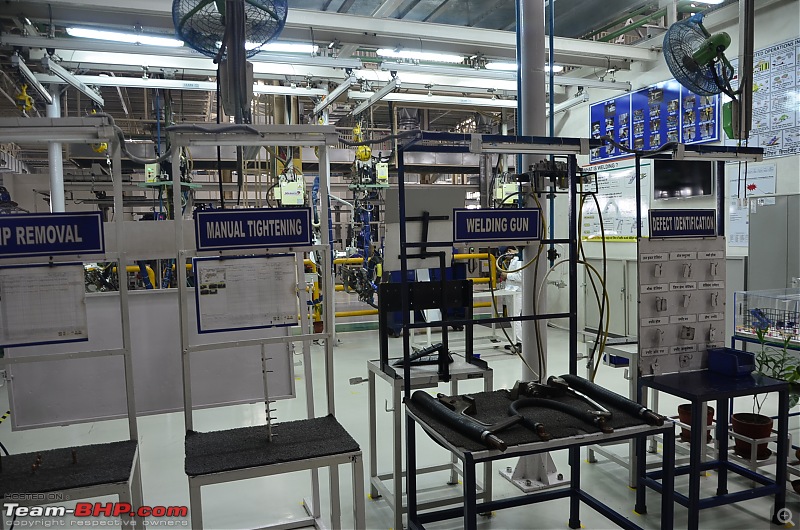 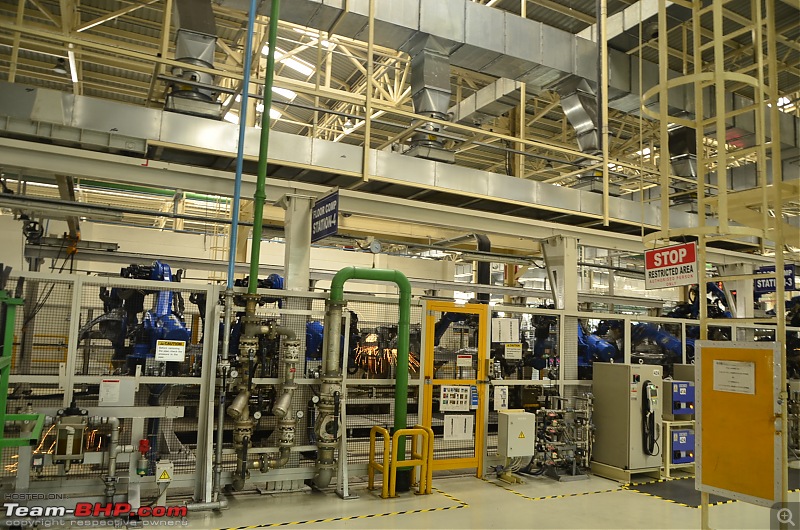 Hood inspection division: 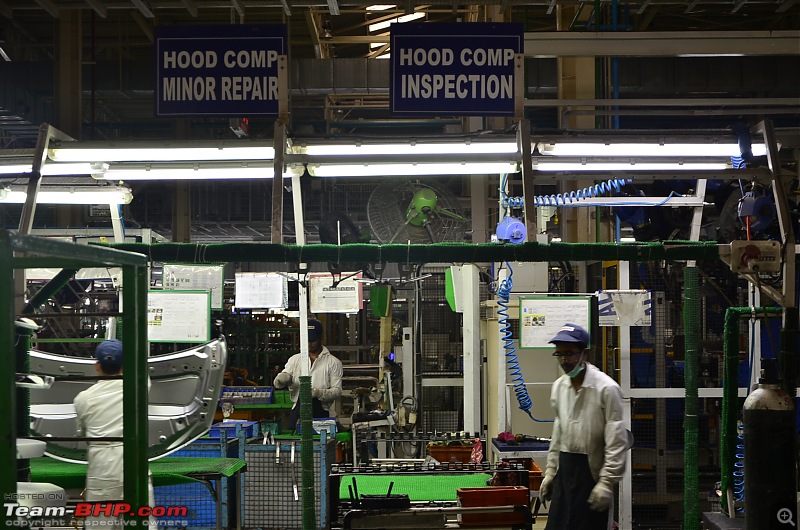 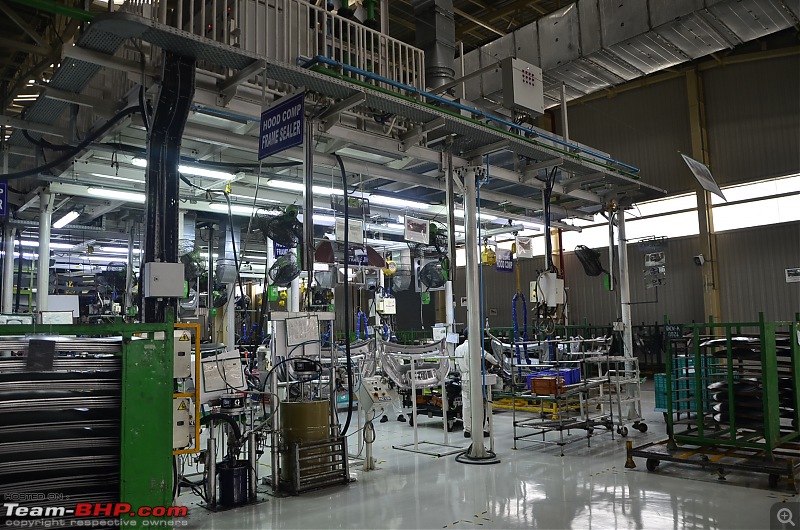 This video captures the assembly line movement of this process: We are thanked for visiting the weld shop  : :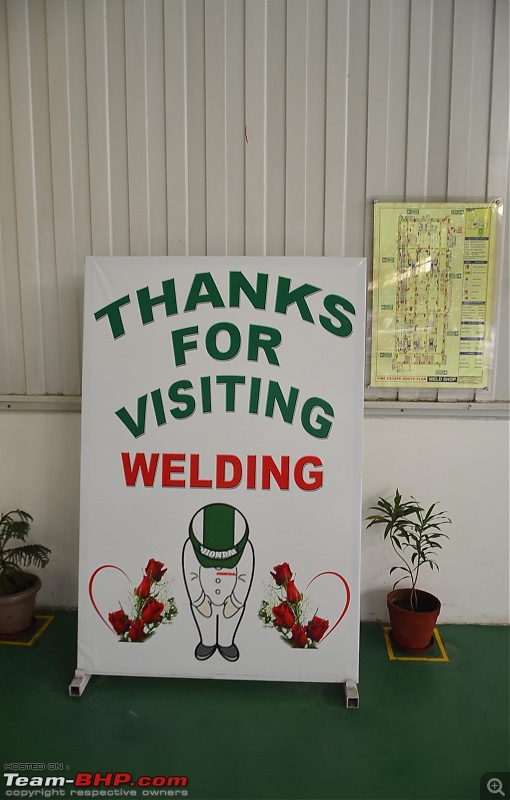 Last edited by Aditya : 4th September 2017 at 10:43. |
| |  (23)
Thanks (23)
Thanks
 |
| The following 23 BHPians Thank mobike008 for this useful post: | Aditya, aeroamit, anshumandun, BlackPearl, blackwasp, CarguyNish, carrazy, GTO, Haroon, Jaggu, Leoshashi, libranof1987, Mevtec, Nohonking, phoenixash, RavenAvi, Rehaan, samabhi, Simhi, skchettry, SS-Traveller, theexperthand, uday.ere |
| | #9 |
| Distinguished - BHPian  | Assembly - Engine As we inch closer to the final amalgamation of a spanking new vehicle, the heartbeats kept rising! Here is where the heart of the matter lies - engine assembling, which as we all know is the core function of any automobile manufacturing process. It was surreal to watch the engine blocks and heads from the casting shops being transported from the other building on an overhead conveyor, bringing all these parts into this dedicated building where the entire engine is assembled. First, the chain case is installed on the block. The immediate next step is the installation of the pistons, crankshaft, cylinder head and flywheel. The cylinder head in itself gets a separate sub-assembly line, wherein the valves, springs, stems and injectors are installed. Once the above parts are all assembled onto the die casted engine block, it goes for a leak test. Post its successful completion, the final engine is again shipped on an overhead conveyor, to land up at the chassis section of the main assembly line. All engine fluids will be filled once the engine goes inside the car. Resting area within the Engine Assembly section: 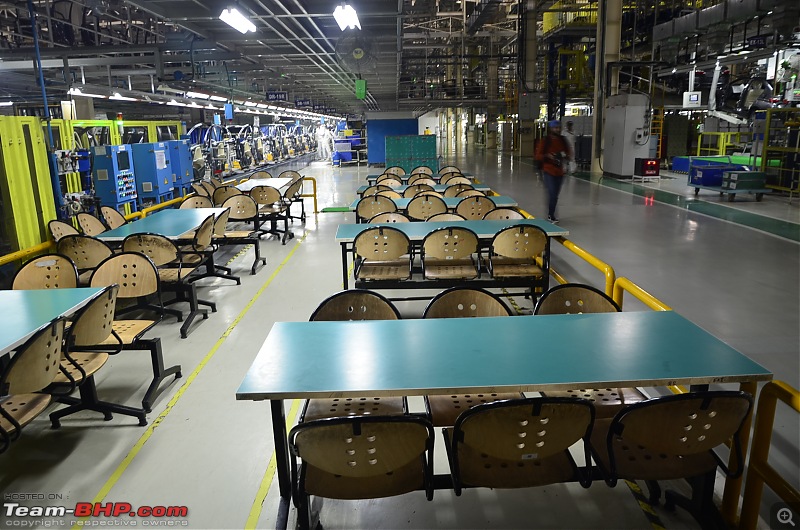 Engines hanging on the conveyor belt. They keep passing over the workers who have a specific inspection task: 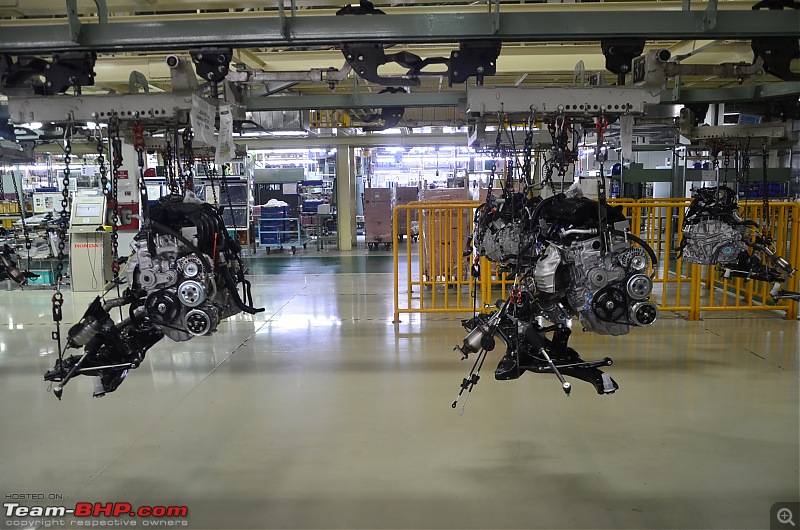 Video highlighting workers inspecting and fitting components to the engine: Inspection and assembly in progress: 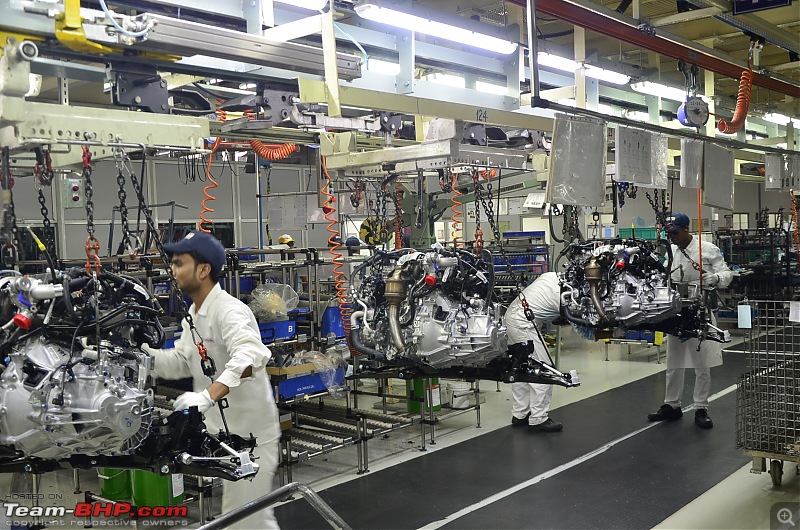 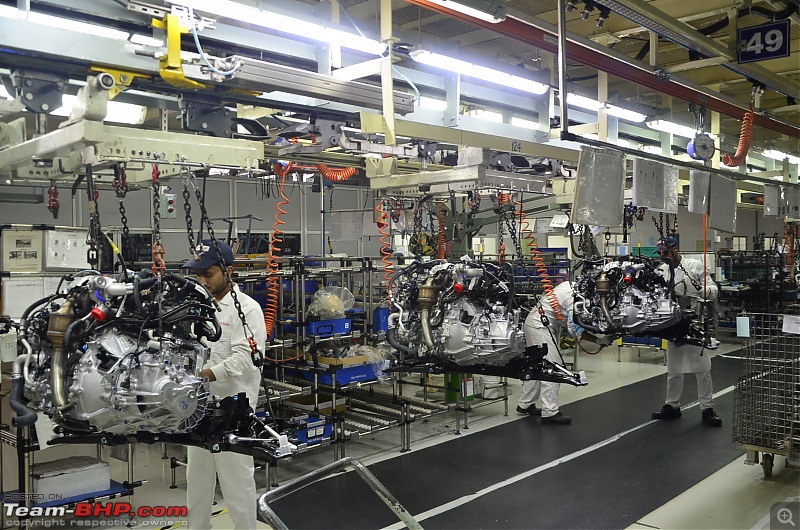 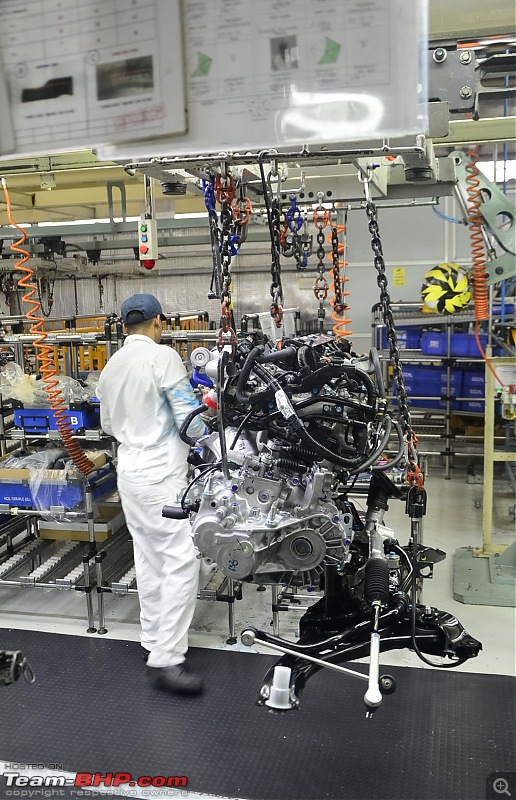 Engine oil being topped up: 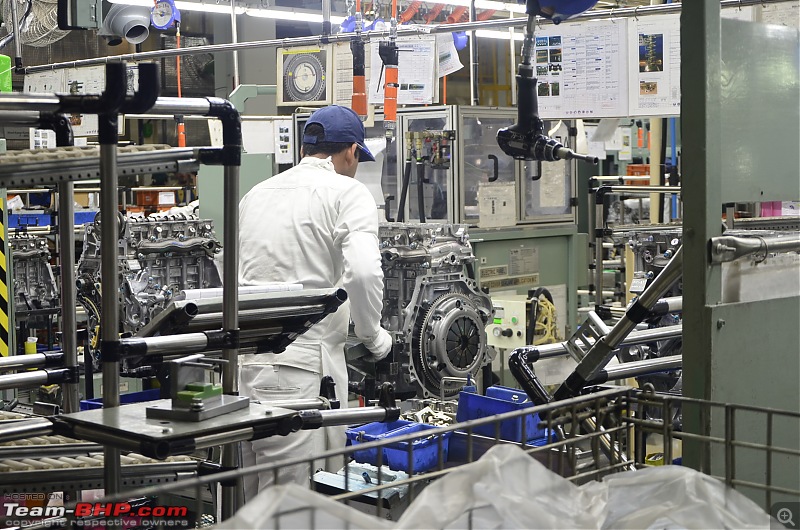 Wasted oil etc. goes into these bins: 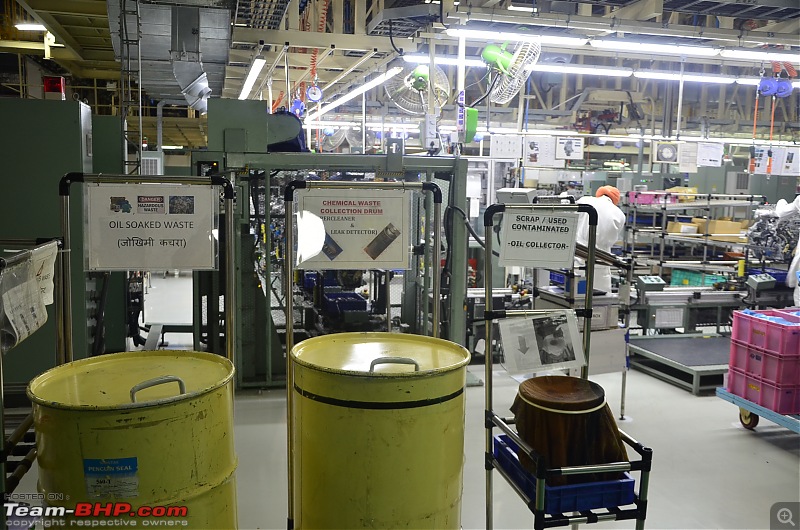 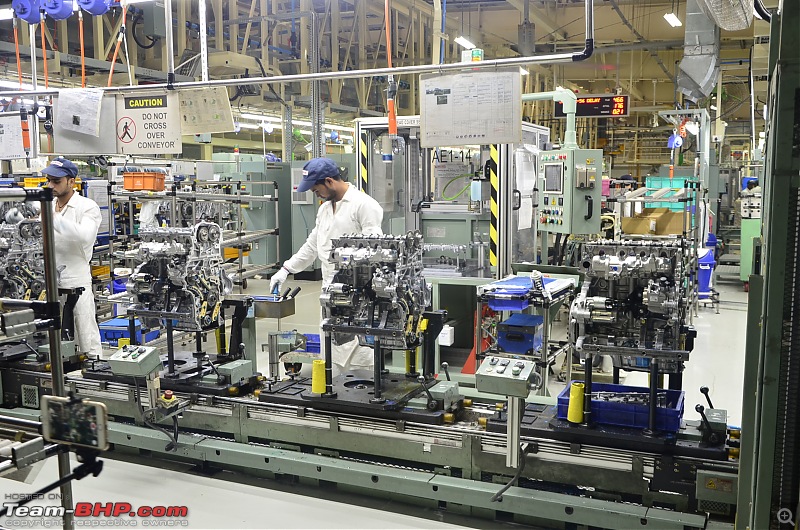 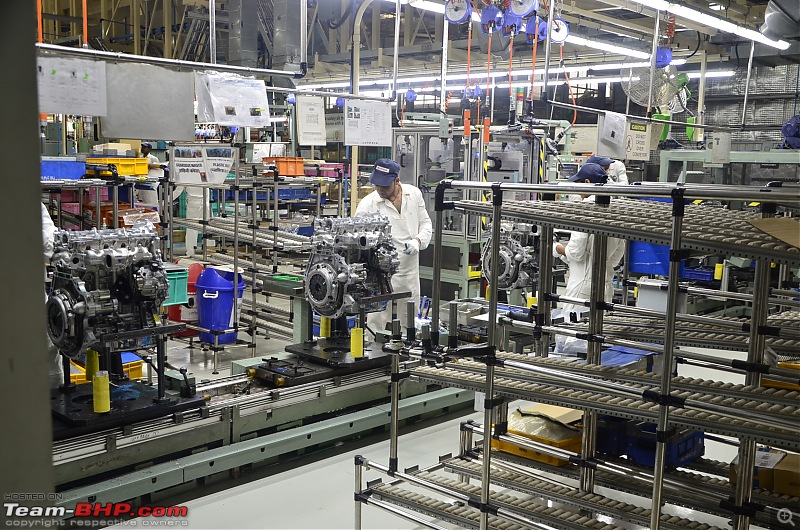 View of the engine assembly area; it was a sight to behold - so many engines under one roof: 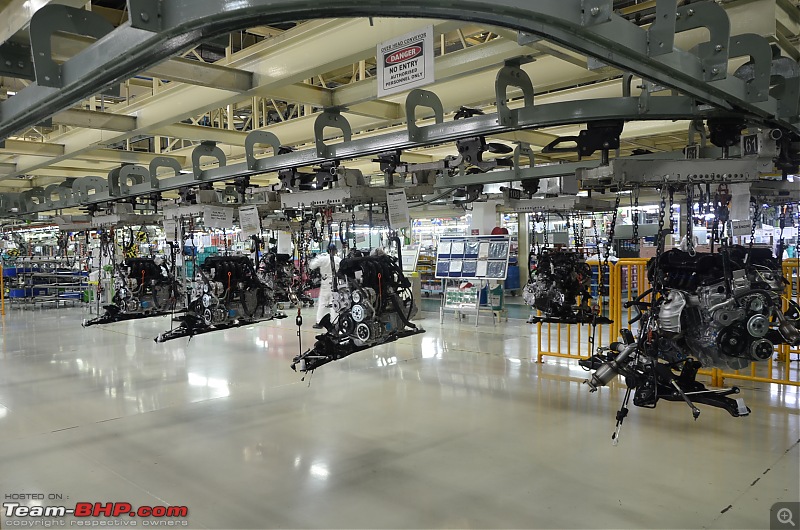 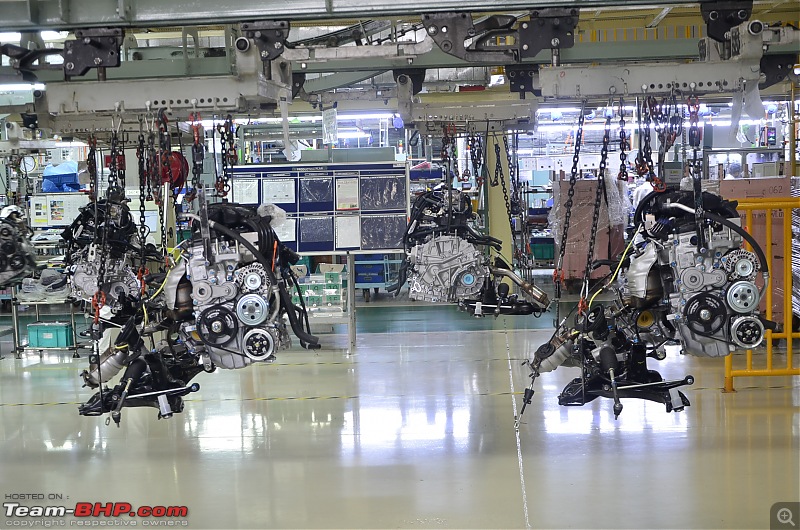 More details of the engine assembly check in this video: Last edited by Aditya : 4th September 2017 at 10:44. |
| |  (22)
Thanks (22)
Thanks
 |
| The following 22 BHPians Thank mobike008 for this useful post: | Aditya, aeroamit, anshumandun, BlackPearl, blackwasp, CarguyNish, GTO, Haroon, Jaggu, libranof1987, Mevtec, Nohonking, phoenixash, rakesh_r, RavenAvi, Rehaan, samabhi, shipnil, Simhi, skchettry, SS-Traveller, theexperthand |
| | #10 |
| Distinguished - BHPian  | Assembly - Frame This section of the Tapukara plant has 4 different zones, similar to the weld shop. The painted car body shell with the doors, hood and trunk is received from the Paint shop. The first thing that is done on its arrival is the removal of all four doors for easy access to put the interior trim into the bodies. Overhead conveyors lift the doors in the same sequence to that of the cars being on the assembly line, and at a later station, the exact same doors (belonging to a particular car) are re-married with the body again. The four zones include: Wiring Zone: The work starts from here. The inside of a car is laid down with the wiring harnesses, running crisscross from front to back. These wires are put inside first as the other interior parts that would come over through the later stations conceal them. Interior Zone: All the interior parts, including the carpeting, seats, dashboard, seatbelts, central console etc. are gradually added through the several stations in this zone. Chassis Zone: This area takes care of the engine compartment, the underbody and the suspension parts. The dampers are mounted, front sub-frame and the rear torsion beams go in, the fuel tank is placed and the engine is moved inside its room. And finally, last but not the least, the wheels are mounted and the car, for the very first time, is ready to stand on its own feet! At the next station, it comes down from the overhead conveyor, on which it was hanging until now. Exterior Zone: As the inside work is done, it is time to call the doors back. The doors come to meet the car again and other external parts, including ORVMs, windshields, wipers and emblems are added to the car. The compressor is topped to the brim with the A/C refrigerant and most importantly, around 2-3 litres of fuel is also put inside the tank. The final car, super-hot off the oven, is almost ready now! This entire zone takes care of wiring, interior, suspension and exteriors: 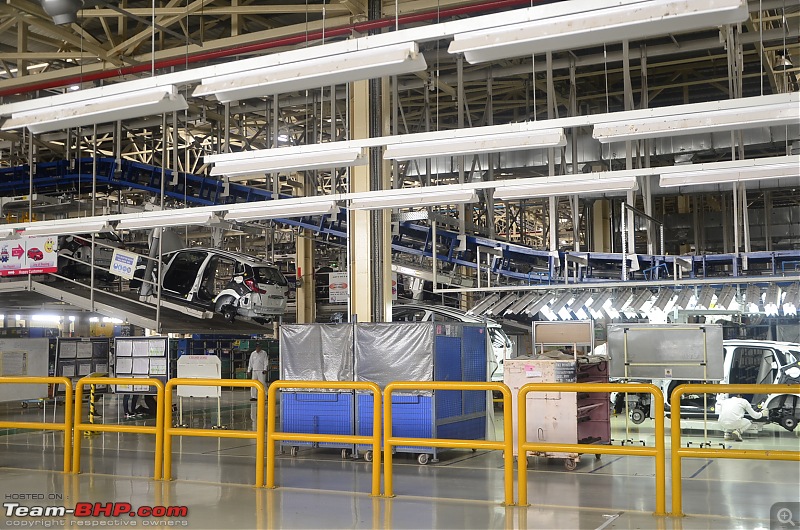 WR-Vs being manufactured. It's on the conveyor belt to the chassis zone: 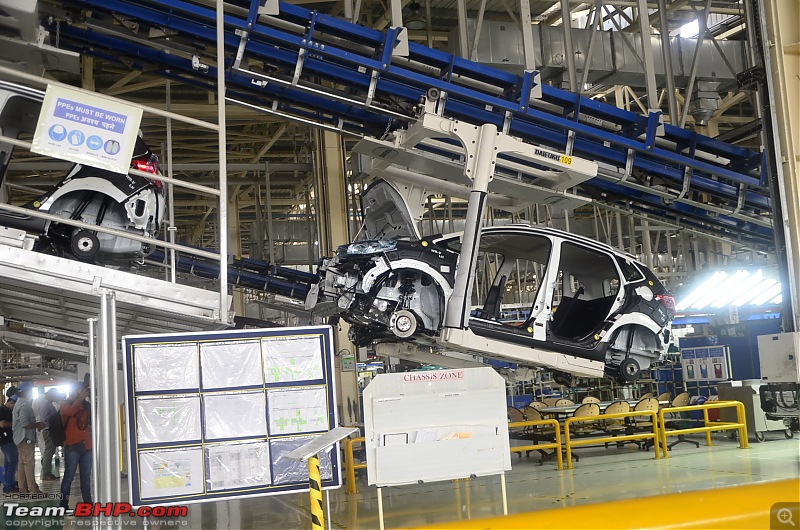 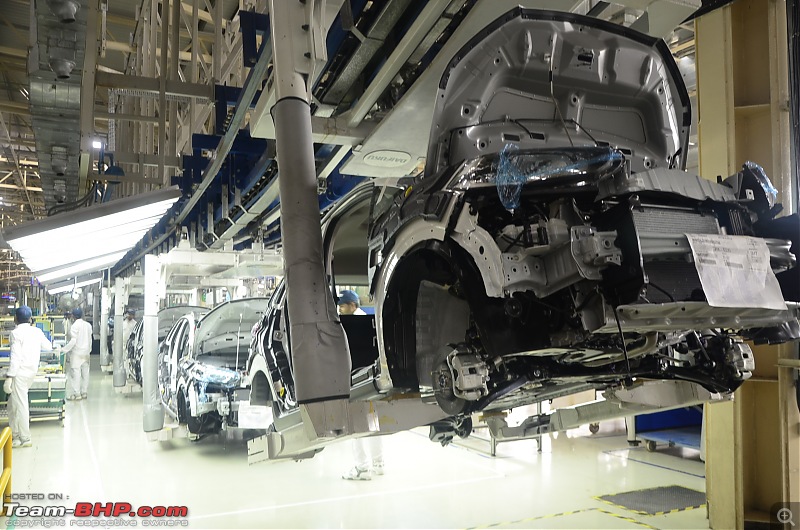 Chassis check and inspection happening at this point: 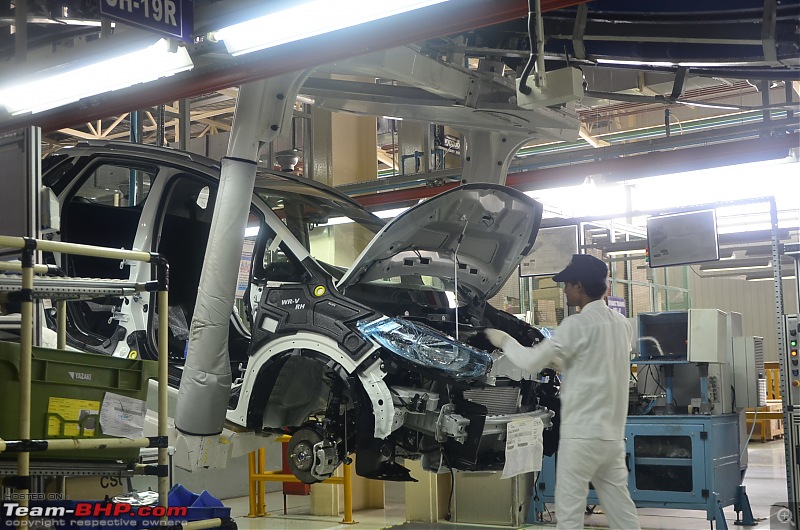 The WR-V is now lowered and passed on to the next section - Installation of glass: 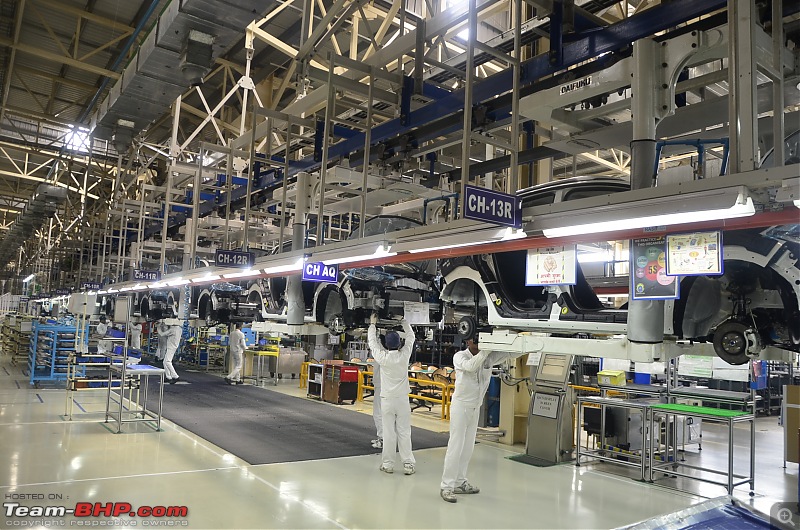 Front and rear windscreens are fitted here: 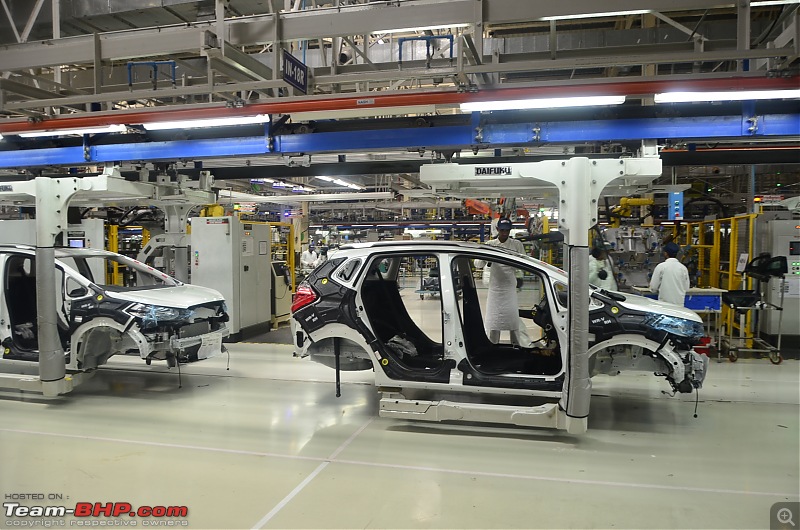 Windscreen installation in progress: 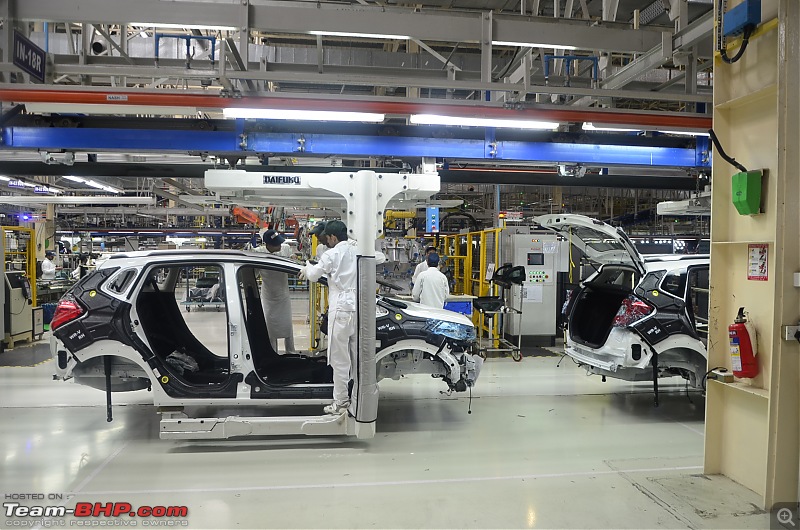 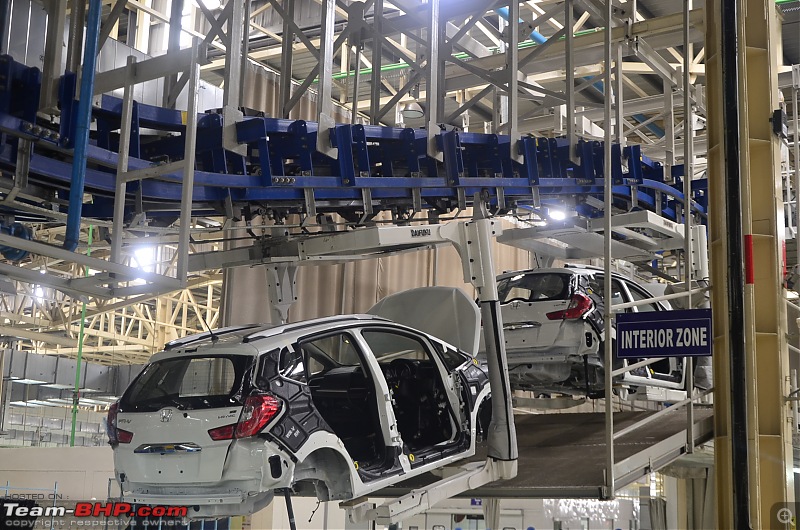 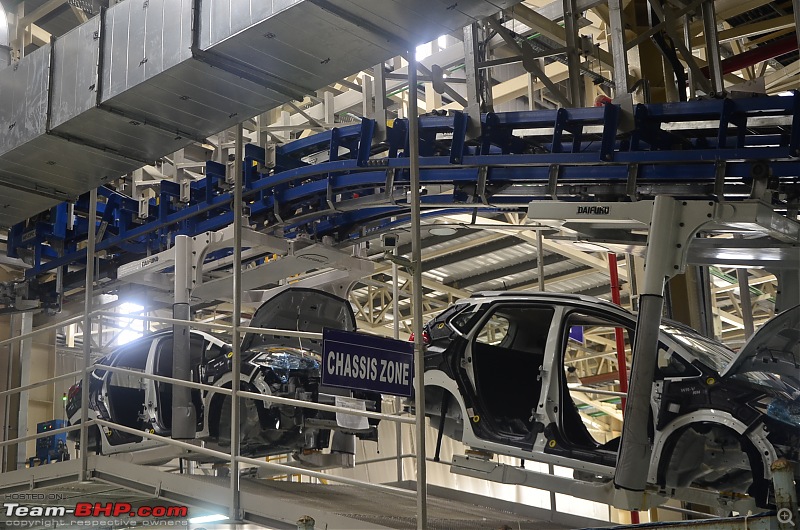 These videos show how the robots keep the glass ready, whereas the workers carry them over to the car and fix the front & rear windscreens in a jiffy: Last edited by Aditya : 4th September 2017 at 10:44. |
| |  (18)
Thanks (18)
Thanks
 |
| The following 18 BHPians Thank mobike008 for this useful post: | Aditya, aeroamit, anshumandun, BlackPearl, blackwasp, CarguyNish, GTO, Haroon, Jaggu, libranof1987, Nohonking, phoenixash, RavenAvi, Rehaan, Simhi, skchettry, SS-Traveller, uday.ere |
| | #11 |
| Distinguished - BHPian  | Vehicle Quality The car goes through a Vehicle Quality section now, where it is first rolled through a section of bright lighting. With light being thrown around the lower section of the body and from top, minute paint discrepancies and panel gaps are noted and corrected here. Post the above activity, the car rolls off the assembly line and goes over to get the wheels, the headlights and the wiper jets aligned, before it finally rolls out in the truest sense. Car Quality Assurance The Tapukara plant has an indoor test track, which is a short 500-meter facility used to do the normal dynamic testing of every car, including shower test, steering test, brake test and road noise test. Every car gets its own Complete Vehicle Inspection Chart (CVIC), recorded against its VIN. It is filled at every inspection check point since the commencement of the Vehicle Quality (VQ) stage. There is another Car Quality Assurance (CQA) area where cars are parked and it is ensured that all the comments mentioned on the CVIC, related to any abnormality or defect being noted, are taken care of. Then, the stereo and light fuses are removed, kept in the glovebox and the car is finally dispatched to the stockyard, situated alongside. On an average, a Honda does close to 3 kilometers of driving inside the plant before being loaded on the truck to reach the dealer. The fuel and brake lines: 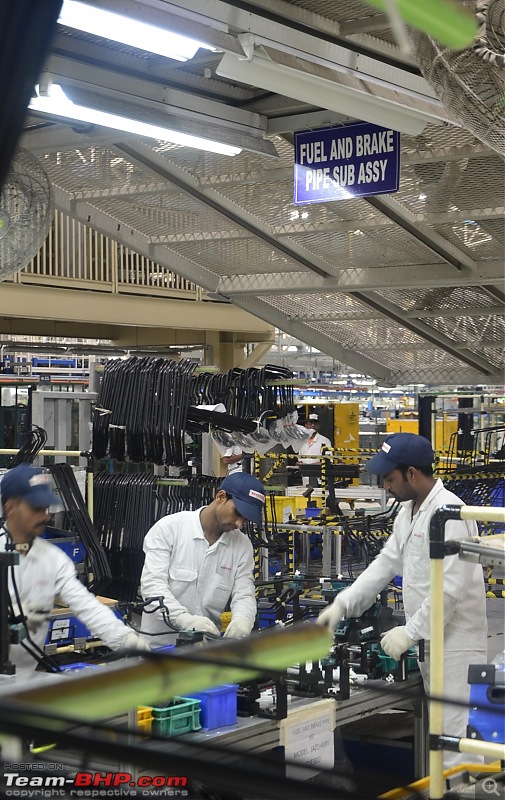 Indoor test facility: 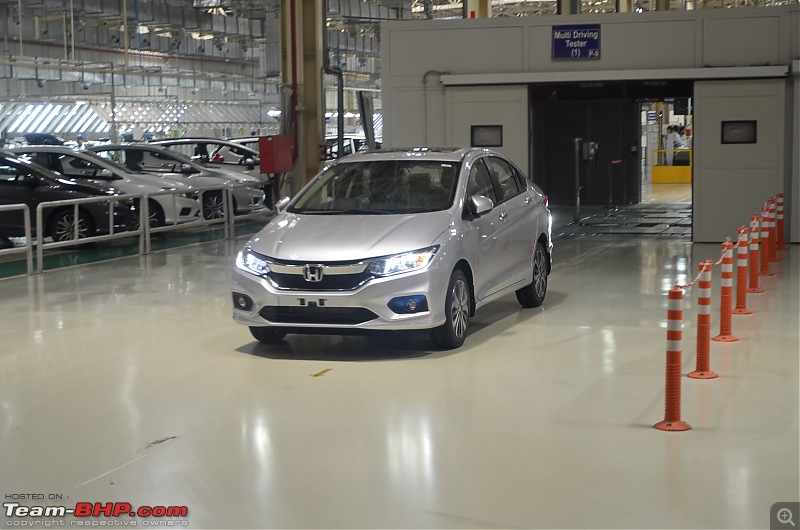 This area is absolutely silent and you don't hear a single thing when a Honda City silently whizzes past you and goes through some basic checks like water, wiper, brakes, headlamp assembly check and angling etc.: 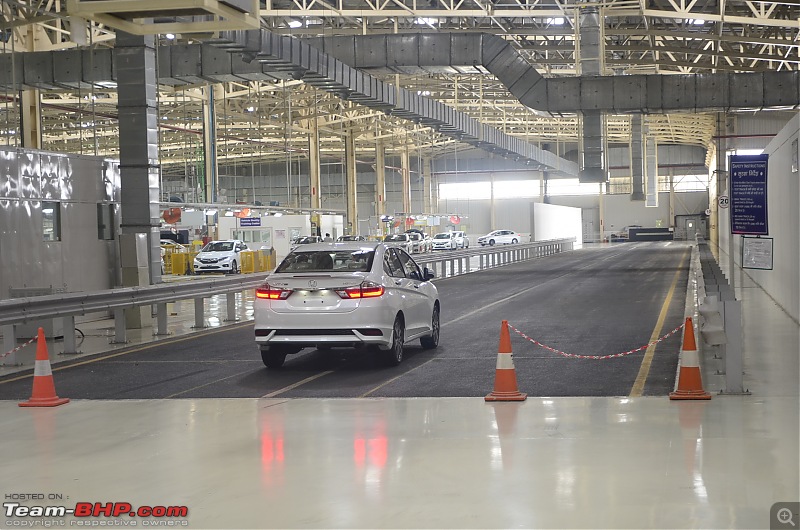 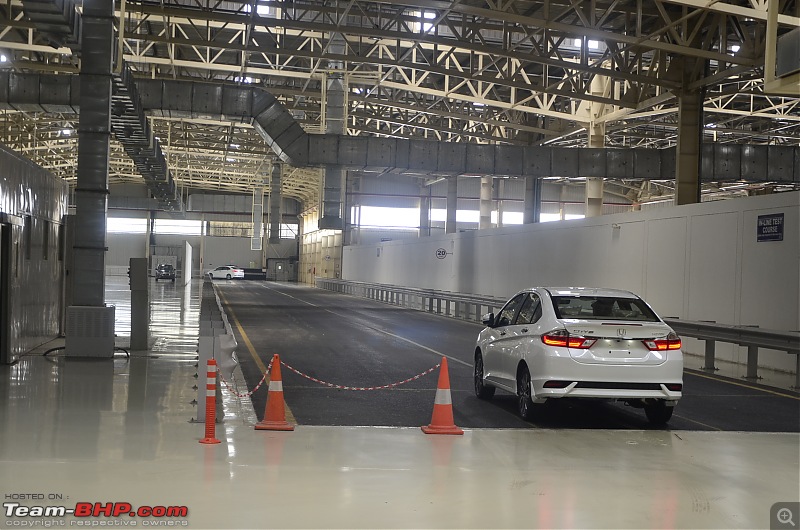 Once the above test is successfully carried out, the car is lined up for visual inspection and other quality control checks: 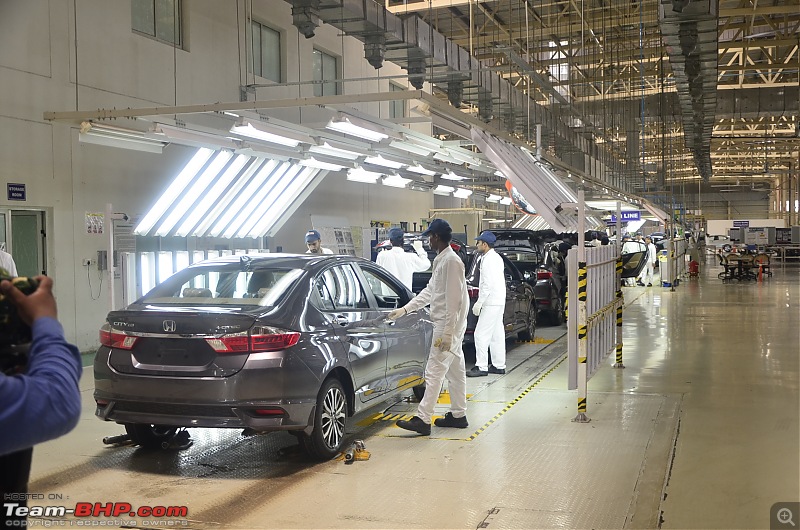 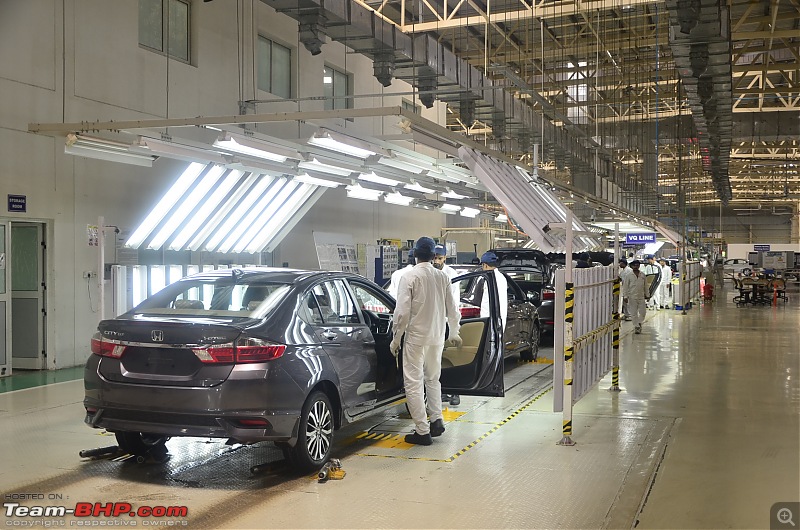 Ready for the final inspection and dispatch: 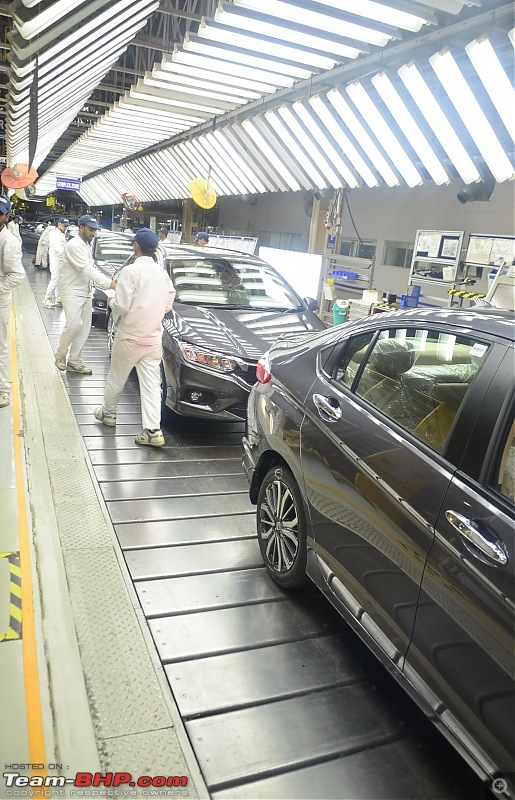 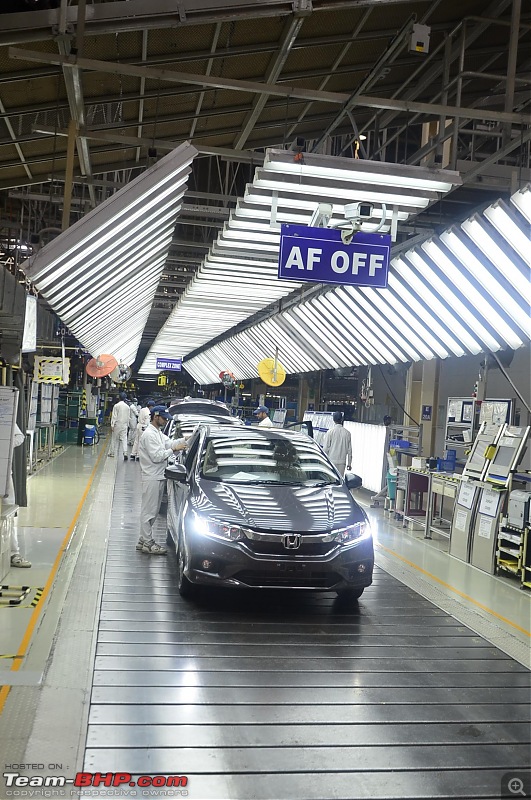 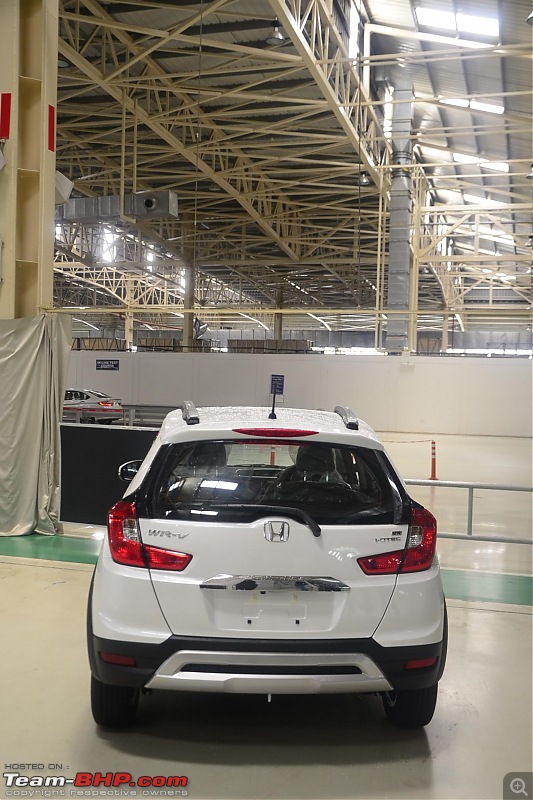 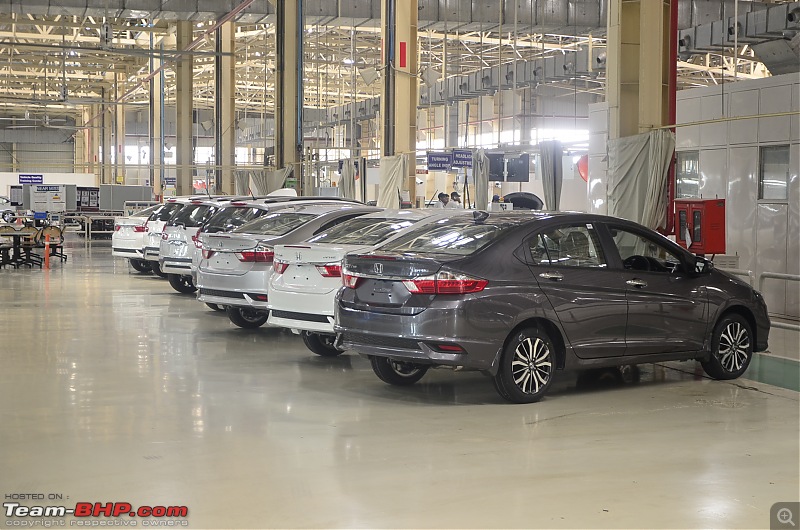 Short video showing the final checks being made on the Honda City: On an ending note, I would like to thank BHPian Forester who is from a different publication and an ex-employee of HCIL. He is an ardent follower of Team-BHP and has profound knowledge of the manufacturing process. He stuck with me throughout & explained everything patiently to me during the guided tour. Forester not only introduced me to the HCIL CEO, but also shared some fantastic insights that helped me put this report together. Disclaimer: Honda invited Team-BHP for the factory visit. They covered all the travel expenses for this event. Last edited by Aditya : 4th September 2017 at 10:45. |
| |  (54)
Thanks (54)
Thanks
 |
| The following 54 BHPians Thank mobike008 for this useful post: | .anshuman, aabhimanyu04, Aditya, aeroamit, BlackPearl, blackwasp, CarguyNish, carrazy, cbatrody, dailydriver, Divya Sharan, Dr.Naren, ego4evr, Fraz33r, grkonweb, GTO, Haroon, i74js, Jaggu, jetti, Keynote, Leoshashi, libranof1987, LoneRidder, manij, MaxTorque, mazda4life, Mevtec, mmmjgm, Motard_Blr, Nohonking, phoenixash, punterccrx8s, rakesh_r, RavenAvi, Rehaan, sairamboko, samabhi, sdp1975, shipnil, Simhi, skchettry, skn1980, spdfreak, sri_tesla, SS-Traveller, supremoo, tharian, The Rationalist, TorqueTwist, uday.ere, VaibhaoT, vigsom, yoscenario2000 |
| |
| | #12 |
| Team-BHP Support  | Re: Pics: Inside Honda's Rajasthan Factory. Detailed report on the making of Hondas Thread moved from the Assembly Line to the Indian Car Scene. Thanks for sharing! |
| |  (4)
Thanks (4)
Thanks
 |
| The following 4 BHPians Thank Aditya for this useful post: | GTO, mmmjgm, mobike008, uday.ere |
| | #13 |
| BHPian Join Date: Jul 2017 Location: Mumbai/Oman
Posts: 66
Thanked: 192 Times
| Re: Pics: Inside Honda's Rajasthan Factory. Detailed report on the making of Hondas Excellent work Sir  . The details and the pictures tell the amount of hard work that you have put in. Had always been wondering what an automobile plant would look like from inside. Although I live close to Mahindra's 'Jeep' Division, never got a chance to visit it. . The details and the pictures tell the amount of hard work that you have put in. Had always been wondering what an automobile plant would look like from inside. Although I live close to Mahindra's 'Jeep' Division, never got a chance to visit it. Thanks for sharing. Sravan |
| |  (1)
Thanks (1)
Thanks
 |
| The following BHPian Thanks skchettry for this useful post: | mobike008 |
| | #14 |
| Senior - BHPian Join Date: Nov 2009 Location: RJ-02,DL,MH-12
Posts: 1,331
Thanked: 2,181 Times
| Re: Pics: Inside Honda's Rajasthan Factory. Detailed report on the making of Hondas Thanks for this lovely post. Just wanted to ask few questions - Is 500 m indoor testing space enough for final inspection and confirmation that the car is good for sale? Ford, Hyundai and Tata have proper tracks within their factory premise to do a detailed testing - Are there any crash testing facility @ the factory? - You mentioned at the start about Paint booth and how it is out of bound for the media visit; can you please give some insights about Honda paint process (whatever you could get to know?) Cheers ! |
| |  (1)
Thanks (1)
Thanks
 |
| The following BHPian Thanks i74js for this useful post: | mobike008 |
| | #15 | |
| BHPian Join Date: Mar 2012 Location: Sydney, AU
Posts: 935
Thanked: 797 Times
| Re: Pics: Inside Honda's Rajasthan Factory. Detailed report on the making of Hondas Great to see an automobile manufacturing plant. Well covered  . We should appreciate the cleanliness maintained inside and outside the factory. . We should appreciate the cleanliness maintained inside and outside the factory.Quote:
- I don't think there is a crash testing facility in Honda Tapakura Plant, for that matter I don't think any of the car manufacturers (R&D units may have like Mahindra Research Valley) in India have a proper crash testing facility. My knowledge is limited. - Honda's painting process is solvent based painting process with Three Coat One Baking process (3C1B) ie three layers of coating and one step baking process, which is the latest trend in the painting process. This is a very economical process in terms of operational cost and capital investment. The quality of output is slightly inferior compared to the conventional (3C2B) but very profitable for the manufacturer. So slowly this process is becoming very popular in India (among volume players). Generally, the painting process requires very stringent ambient conditions (temperature, humidity, dirt levels). So it very difficult to manage with lots of visitors (especially in groups). Also, safety is another major concern. There are many conveyors, electro deposition processes, VOCs etc. Every manufacturer wants to keep some level of secrecy. These are all the reasons to restrict visitor in Paintshop. Let us wait for Mobikes reply. | |
| |  (6)
Thanks (6)
Thanks
 |
| The following 6 BHPians Thank MaxTorque for this useful post: | GTO, i74js, mobike008, samschenker, SS-Traveller, uday.ere |
 |


